Assimilation
This article regards assimilation of lifeforms, see Assimilated Vessels for details of how the Borg proceed with the assimilation of starships.
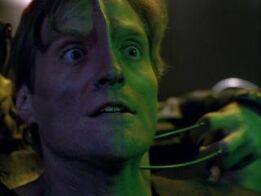
Injection tubules protruding from the knuckles and assimilating a member of species 10026.
Assimilation is the term used in the 24th Century to refer to the process of the Borg Collective taking other lifeforms, technology, vessels and even entire planets by force and enslaving them. In doing so all of the species relevant (useful) knowledge and experience is retained and absorbed in-to the Hive Mind and redistributed to every single member of the Borg Collective where as the irrelevant information is simply disregarded and erased.
Not all species qualify for assimilation, the first aspect of their culture the Borg seek to attain is increasingly advanced technology, vessels, stations or orbital devices which possess significantly high power signatures, warp signatures also the possession of noteworthy weapons or defense systems will be considered sufficient grounds to warrant assimilation. However demonstrating the possession of standard warp technology and particle weapons are by themselves insufficient grounds for assimilation, when the species displays poor technological capabilities they must then possess beneficial or unique biological traits such as a display of extremely high intelligence, physical strength or mental prowess.
- 1 Early 24th Century Assimilation Process (2366-2373)
- 2 Partial Assimilation
- 3 Late 24th Century Assimilation Process (2373+)
- 4 Enhancement Summary

Early 24th Century Assimilation Process (2366-2373) [ ]
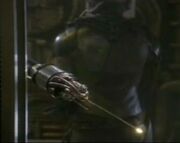
Assimilation Arm aboard the Borg Cube as evidenced in ( TNG Best of Both Worlds ).

Drilling through the pupil as evidenced in ( Star Trek: First Contact ).
The initial method of the assimilation process in the 24th century involved significant psychological trauma to the victim primarily due to the extensive biological augmentation being carried out whilst the victim is still conscious. Firstly, drilling through the eye pupil for the implantation of the cortical array and neural transceiver directly into the brain - which enhances all higher brain functions for language, memory recall and processing power in preparation for uplinking to the Collective consciousness. Secondly, replacement of the eye entirely with an occipital implant designed to allow the attachment of ocular implants. Next the individual's body is refitted with synthetic organs which produce all of the nutrients which the biological systems require, including oxygen for the blood; their only requirement being regularly recharged via the alcove. Following those steps, the drone is then outfitted with an exoskeleton and a multitude of additional technological devices designed to fulfill multiple functions and maintain their uplink to the Hive Mind. Then a very long automated arm, which could presumably only be mounted within a Borg vessel, would inject the individual, altering the victim's body's physiology with a retrovirus, re-writing the lifeforms genetic code to more closely resemble the Borg's. In addition to the physical mutilation that occurs, being assimilated as a Borg Drone robs a person of their individuality, enslaving them to the will of the Collective.
Partial Assimilation [ ]
Drones whom have been newly assimilated and have not yet under-gone complete biological augmentation require additional time to progress through the assimilation
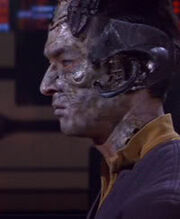
A partially assimilated ensign.
process and are only able to be enhanced as far as nanoprobes can take them. Certain functions compared to the completed drones such as: regeneration in an alcove are not yet possible nor required.
Firstly upon injection the nanoprobes immediately latch on-to and utilizing a retrovirus , attack the cells by re-writing their DNA coding and altering the victims biology, preventing the body from rejecting foreign objects and the plethora of synthetic devices to follow. When the process is completed the life signs do not read as human anymore (Ent - Regeneration.) This first step paves the way for all other major biological changes which follow. Some minutes in-to the assimilation process the nanoprobes which have infiltrated the brain begin inducing a temporary coma to protect the brain from psychological and physical damage as the nanoprobes being reconfiguring the neural pathways, allowing the brain to tune in-to the frequency of the hive mind and hear the voices of near-by drones at close range without any technological aid (Voy - Dark Frontier, First Contact, ENT - Regeneration). While the brain is undergoing the continuing process of restructuring the entire autonomic and renal system in the body are all being augmented and replaced by devices.
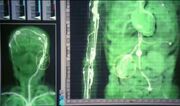
Scans showing nanoprobes modifying the internal organs.
Organs such as the heart, spinal chord, blood vessels, salivary glands, pancreas, hair and sweat glands are all replaced and controlled by Borg devices which allow their bodies to synthesize the nutrients their biological systems require and remove the need for ingestion. The lungs under-go a similar transformation - a device is constructed by the nanoprobes which allows oxygenation of the blood and removed the drones need to inhale gasses. The musculature is also greatly enhanced throughout the entire body granting the partially assimilated drones strength at least two times greater than that of humans.
Roughly twenty minutes following infection, the nanoprobes complete the neural transceiver which will connect the victims mind to the Collective consciousness once the restructuring of the neural pathways are complete. As more and more technology is completed and the drone is able to function as a low-class drone and is supported entirely by its technology. Around 25 minutes following infection the nanoprobe injection tubules are constructed, enabling the drone to assimilate other lifeforms immediately upon activation. Half an hour following infection and almost total transformation of the body, the restructuring of the neural pathways is nearing completion, in order for the brain to finally be connected with the hive mind the technology must restart the victims brain - resulting frequently in a loss of the victims short term memory (Ent - Regeneration) and leading to the subject regaining consciousness. Once the brain pathways are sufficiently active and the subject regains a state of high awareness the connection to the hive mind is finally established allowing the drone to receive its instructions and begin carrying them out. Upon achieving an uplink to the Collective and activation of the drone most of the nanoprobes receive instructions to lay dormant in the victims blood stream as most biological regeneration will now be influenced by the Collective uplink. Already possessing weaponry in the form of enhanced strength and injection tubules, the nanoprobes immediately begin construction of the drones personal force field, due to the drones completion and most of the nanoprobes now laying dormant, the construction proceeds significantly slower and is completed circa 45 minutes after infection. One of the final modifications before completion of the partially-assimilated drones technology is the spinal clamp - a form of technology housing the spinal chord which speeds up neural transmission activity, protects the spine from damage, regenerates the spine when broken or damaged and strengthens the spine, allowing drones to fall or leap from great heights without trouble or spinal damage.
- Skin pigmentation and alteration via DNA manipulation
- Neural Pathway restructuring resulting in loss of consciousness
- Complete biological regeneration
- Musculature and skeletal enhancement - super strength
- Interlink node
- Injection tubules
- Group Consciousness
- Personal force field
- Spinal clamp
Late 24th Century Assimilation Process (2373+) [ ]
Sometime between 2366 (TNG - "Best of Both Worlds") and 2373 (VOY - "Unity") the method of assimilation by the Borg had drastically altered, presumably due to the Borg assimilating nanoprobe technology.
Inside of or attached to the victims head are a: Vocal subprocessor, Ocular implant, Cortical implant, Cortical array plus Cortical Node,Cranial transceiver, Interlink node, Neural processor, Neuro-processing adjunct, Neural transceiver, Sensory node Inside of or attached to the victims chest are Designator interface circuits, a Microconnector, a Regenerative shield, a Thoracic assembly.
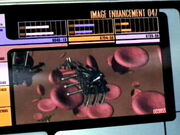
Nanoprobes assimilating blood cells as evidenced in (VOY - "Scorpion")
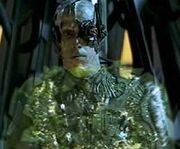
Borg Drone adapts, using the regenerative shield as evidenced in (Star Trek: First Contact)
However following the eventual assimilation of nanoprobe technology the Borg drones abilities and technology drastically improved. The link between the technological and the biological was finally truly achieved and the entire assimilation process was retro-fitted with the implementation of injection tubules and nanites. A process which once took hours could now be achieved within a matter of minutes due to the nanites ability to quickly assimilate the subject and even construct essential devices in such as a Neural Transceiver.
The assimilation of the Nanoprobe technology firstly granted the drone astounding inherent regenerative abilities, withstanding being frozen for hundreds of years then regenerating and returning to a fully-functional state ENT - Regeneration . Nanoprobes in conjunction with the Ocular Implant also allowed the Borg Drone to alter their bio-electric field to any frequency they require by scanning the holographic fields frequency with the Ocular Implant ( Star Trek: First Contact ), and sending that information to the nanoprobes which then proceed to alter the drone's bio-elecric field within a matter of seconds.( VOY - Hope and Fear ). In addition to the regenerative shield possessed by all Borg Drones they became a truly unstoppable force, passing freely through forcefields and adapting to particle weapons fire.
Enhancement Summary [ ]
- Super-human strength via the prosthetic limbs and exoskeleton.
- Discharge protection of up-to 5 million gigawatts.
- Enhanced vision , capable of detecting irregularities in space-time.
- Enhanced mental capabilities as a result of the neural processor.
- Infinite knowledge allowing the completion of any task whether it be medical, scientific or engineering due to the drone's uplink to the Collective.
- Particle weapon defense via the personal regenerative shielding.
- Constant transporter lock via the cranial transceiver.
- Enhanced regenerative capabilities and drastically improved immune response via the nanoprobes.
- 1 Borg Collective
- 2 Shape Memory Alloy
- 3 Borg Cube

Star Trek: First Contact
Six years have passed since Captain Jean-Luc Picard was captured and assimilated by the Borg. Now, the Borg make a second attempt to conquer the Federation. Starfleet believes that Picard's experience makes him an "unstable element to a critical situation" and orders him to stay behind. But, when Starfleet's fight does not go well, Picard and the crew of the new USS Enterprise disobey orders to join the fight, following the Borg three hundred years into the past just as Zefram Cochrane prepares to launch Humanity's first warp-capable engine, the Phoenix , and make first contact with an alien race.
- 1.1.1 24th century
- 1.1.2 21st century
- 1.2 Act Two
- 1.3 Act Three
- 2 Log entries
- 3 Memorable quotes
- 4.1 Development
- 4.2.1 The New Enterprise
- 4.2.2 Interiors
- 4.2.3 The Borg
- 4.2.4 The Phoenix
- 4.3.1 Production history
- 4.4.1 Visual effects
- 4.4.2 Music
- 4.4.3 Promotion and merchandising
- 4.5 Box office performance
- 4.6 Reactions
- 4.8 Apocrypha
- 4.9 Merchandise gallery
- 5 Awards and honors
- 6.1.1 Opening credits
- 6.1.2.1 Motion Control and Pyrotechnics Unit
- 6.2.1 Performers
- 6.2.2 Stunt performers
- 6.2.3 Stand-ins and photo doubles
- 6.2.4 Production staff
- 6.2.5 Production companies
- 6.3.1 Spacecraft references
- 6.3.2 Other references
- 6.3.3 Unreferenced material
- 6.4 Sources
- 6.5 External links
Summary [ ]
Act one [ ], 24th century [ ].

Picard relives his assimilation
Still haunted by memories of his assimilation six years ago , Captain Jean-Luc Picard awakes from a nightmare to wash his face. In the mirror, he is surprised by a Borg assimilation unit emerging from under his skin on his face. Awakening for real, Picard receives a communiqué from Starfleet Command . Appearing on his desktop terminal , Starfleet Admiral Hayes relays distressing news that Picard partially guesses from his dream: a Borg cube has attacked a Federation outpost on Ivor Prime and crossed into Federation space.

Picard announces the Enterprise will not be participating in the battle with the Borg
Picard dutifully informs his crew that they are to take the new Sovereign -class USS Enterprise -E to patrol the Romulan Neutral Zone , a minor threat compared to the Borg. In the Enterprise -E's observation lounge , the senior crew members protest and are confused as to why the most advanced ship in the fleet is being relegated to a relatively unimportant task; the Romulans have not caused any incidents recently and would almost certainly not take the opportunity to start a conflict. Picard doesn't disagree with the protests but is compelled to follow orders. He later confides to first officer William T. Riker that the reason Starfleet is keeping the Enterprise away from the Borg is due to Picard's history with them. Riker emphatically disagrees with Starfleet's decision, saying that given Picard's experience with the Borg he should be leading the fight instead of being kept away from it. They then receive word that the fleet has engaged the Borg and listen as the battle appears to go badly.

" Set a course for Earth. Maximum warp. "
Picard announces his intention to commit a direct violation of their orders and that if anyone on the bridge objects, it will be noted in his log. The crew votes unanimously to disobey their orders and set a course for Earth at maximum warp, where they join a fleet of vessels repelling an advancing Borg cube. Among them is the badly-damaged warship USS Defiant commanded by Lieutenant Commander Worf . With the ship under heavy fire and its shields and weapons gone, he orders that the Defiant ram the cube when he is informed that the Enterprise has arrived. As the Defiant 's survivors are beamed aboard, Riker reports that the fleet admiral's ship has been destroyed. Informed by Data that the cube's outer hull has been heavily damaged and its power grid fluctuating, Picard has a good look at the cube on the viewscreen and uses his remaining connection to the Borg to briefly "listen in" on them. Picard takes command of the fleet and swiftly destroys the cube by ordering all vessels to target a seemingly insignificant region of the cube. As it explodes, however, the foundering Borg ship launches a sphere -shaped vessel into orbit of Earth.

The Enterprise -E enters the temporal vortex
Worf arrives on the bridge and (after being formally welcomed aboard the Enterprise -E) offers his assistance. He asks about the status of the Defiant and is relieved when told it is adrift but salvageable. Picard requests he takes tactical and Riker jokingly asks if he "remembers how to fire phasers." Suddenly, the sensors detect that the Borg sphere is creating a temporal vortex ; the crew watches the viewscreen as the Borg vessel disappears through the vortex and Earth dramatically changes. Seeing that it is now populated entirely by Borg drones and has a toxic atmosphere only suitable to them, they determine that history has been changed, having been protected from the changes themselves by the wake of the temporal vortex. As the vortex collapses, Captain Picard orders Lieutenant Hawk not to alter course and have the Enterprise follow the Borg into the past – to repair whatever damage they've done.
21st century [ ]

Lily and Cochrane spot the attackers
In the small shanty town of Bozeman , Montana , Lily Sloane and Zefram Cochrane wander out of a makeshift bar as their town is unexpectedly pulverized by a volley of disruptor fire. Lily and Cochrane run for cover but are unaware that the Borg sphere is responsible for the destruction raining down upon them. Lily suspects that they're under attack by the forces of the Eastern Coalition (ECON).
The Enterprise emerges from the temporal vortex and destroys the Borg sphere with quantum torpedoes . Scanning the surface, the crew discovers that they have arrived on April 4th , 2063 – one day before Earth's First Contact with an alien species, and a decade following the destruction of World War III . Picard surmises that the Borg were attempting to prevent the launch of Earth's first warp -powered craft. He gathers Lieutenant Commander Data and Doctor Beverly Crusher , leading an away team to locate the warp ship's inventor, Doctor Zefram Cochrane.

Picard, Data and the Phoenix
After beaming down, Picard's away team enters Cochrane's missile silo where they find the occupants dead but the prototype warpship, the Phoenix , suffering only minor damage. Picard and Data inspect the rocket but are surprised by Lily, who fires at the Enterprise officers. Impervious to bullets, however, Data intercepts the 21st century woman before she succumbs to radiation poisoning. Doctor Crusher returns to the Enterprise with Lily in her care, promising to keep her unconscious as Picard calls up to Geordi La Forge , asking the chief engineer to bring a repair crew to the silo.

The Borg overrun the ship
As the damage control team departs the ship, engineers Porter and Eiger are left to deal with environmental difficulties that have mysteriously cropped up. One after the other, both officers crawl into a Jefferies tube , wherein they are quietly assimilated by unseen Borg stowaways. Sensing that something is wrong aboard the Enterprise , Picard returns with Data to the ship, leaving Commander Riker in charge.
Indeed, something is dreadfully wrong, as the Borg infiltrate the Enterprise ; Picard surmises that the Borg, knowing their vessel was doomed, must have transported aboard undetected while the Enterprise 's shields were down. Fleeing Borg drones in sickbay , Doctor Crusher is forced to revive Lily. With the help of the Enterprise 's EMH , Crusher, Nurse Ogawa , Martinez , and other medical personnel are able to escape into the Jefferies tubes where Lily quietly slips away while the medical officers flee the deck. On the bridge , Picard orders Data to lockout the main computer with an encryption code as the Borg attempt to take command of the ship. Picard knows that, once the Borg have control of the Enterprise , they will assimilate Earth.
Act Two [ ]

Troi and Cochrane share a drink
Below decks, Picard briefs Data, Worf, and a team of security officers as they arm themselves with phaser rifles (Worf informing the crew that even with a rotating modulation , they will get at most twelve shots before the Borg adapt). As the Borg have taken control of main engineering , Picard explains their objective: puncture one of the warp plasma coolant tanks . Doing so will release the plasma coolant, liquefying the Borg's organic components, without which, Picard explains, the cyborgs cannot survive. Picard also warns his officers that they should not show mercy to assimilated Enterprise crew members – indeed, killing them would be the merciful thing to do.
On Earth, Commander Riker finds a drunken Counselor Troi at the town's makeshift bar. The counselor introduces Riker to Zefram Cochrane, himself intoxicated, explaining that the scientist doesn't believe their cover story – and that, in her professional opinion as ship's counselor , she thinks he's "nuts." Riker is very amused by Troi's drunken behavior, which annoys Troi even more. As Cochrane activates a rock and roll -spouting jukebox , Troi bemoans her first experience with tequila then finally passes out while Cochrane continues to dance to the music.

Picard and Data hunt Borg in the corridors of the Enterprise
Meanwhile, two teams march through the corridors of the Enterprise -E – one led by Worf, the other by Picard and Data. Rounding a corner on deck 16, the crew finds that the usually pristine and immaculate bulkheads of a Federation starship have been replaced by the grotesque and mechanical equipment of a Borg vessel. In response, an anxious Data deactivates his emotion chip . Elsewhere, Worf and his men encounter Dr. Crusher as she emerges from the Jefferies tubes with her medical staff and patients. She notifies the Klingon that Lily has gone missing and Worf promises to watch out for the woman. Moving on, the two teams meet outside of engineering, in corridors crawling with Borg drones. At first ignoring the Starfleet officers' arrival, the Borg suddenly spring into action as Picard and Data attempt to gain entry to main engineering. A battle ensues, but the Borg quickly adapt to phaser fire and Picard calls for a retreat. The captain tells the Enterprise crew to regroup on deck 15 and warns his officers not to let the Borg touch them. Too late, however, for Data, who is captured by the Borg and taken into their hive.

Lily captures Picard
Rushing to a Jefferies tube, Picard sees a crewman begging for help as Borg technology starts to take over his body and, believing he is saving him from a worse fate, shoots him dead before escaping into a hatch. Inside the access tube, Lily catches Picard by surprise, turning the captain's phaser on him and demanding to be returned home. Picard tells her that is not going to be easy at the moment, but Lily informs Picard that he had better make it easy or else she will fire the phaser on him. Picard tells her to follow him and she warns the captain to go slow.
Data awakes in engineering, restrained to a Borg operating table and surrounded by drones. He assures them that they cannot gain the Enterprise access codes stored in his neural net , speaking directly to the disembodied voice of the Borg. The Borg tell Data that breaking the code is only a matter of finding the android 's weakness.

Convincing Cochrane to make his flight
On the surface, Riker, Troi, and La Forge attempt to convince Cochrane that the story about the Borg and their mission is true. Adjusting the scientist's telescope , La Forge gives Cochrane a glimpse of the Enterprise -E, orbiting high above Montana. The Enterprise officers urge Cochrane to continue with his plans to launch the Phoenix , telling him of the Utopian society that warp travel and first contact will bring to Earth. On the same day that Cochrane makes his first warp flight, a survey ship from a neighboring alien race will be passing through Earth's solar system : upon noticing that Humans have discovered faster-than-light travel, they will decide that Humanity is advanced enough to officially make first contact. Thus, even if Cochrane's test flight is simply delayed a few days, it will drastically alter history. If Cochrane hurries to make his warp flight as scheduled, the aliens will make contact, and Humanity will put aside its differences and unite as never before, to rebuild from the world war and, within fifty years, build a utopia on Earth. Grudgingly, Cochrane agrees.

The Enterprise undergoing assimilation
Meanwhile, the fight does not go well aboard the Enterprise . The Borg continue their relentless assimilation of the ship and its crew, taking control of more than half of the starship. In command of the bridge, Worf is informed by Chief of Security Daniels that the Borg have halted their approach after seizing control of deck 11, which contains hydroponics , stellar cartography , and deflector control ; none of which are vital Enterprise systems; Worf is mystified, as the Borg would only have ceased their attack there if they gained a tactical advantage. Meanwhile, still crawling through the bowels of the ship, Picard leads Lily to a porthole looking out over Earth. Shocked to find herself in space, Lily surrenders her phaser and begins to trust the captain.

" The beginning, the end, the one who is many… "
Down in engineering, Data continues his conversation with the Borg Queen , who finally shows herself as a head and upper torso descending to a robotic body. Reactivating Data's emotion chip, the Queen reveals a patch of Human flesh grafted onto his android skeleton. With this new skin, Data is able to feel all new sensations and gets to experience pleasure for the first time when the Queen blows on the flesh.
In a corridor, Picard describes the Federation and the Borg to Lily, who reacts in terror as they enter a section overrun by Borg. As they make their escape, Picard fires his phaser, provoking a response from two drones who pursue them into the holosuite . Activating a holonovel , Picard recreates a scene from The Big Good-Bye , using a holographic Tommy gun to blast the two Borg in a fit of rage. He goes berserk and plans on ripping apart the dead Borg with the gun before being calmed down by Lily. Nonetheless, he starts pulling open the chest cavity of one of the drones when Lily notices the Borg has partial remains of a Starfleet uniform on. Picard unemotionally informs her that the Borg was formerly Starfleet Ensign Lynch . The captain retrieves a Borg neural processor and proceeds to the bridge, surprising Lily at how emotionally detached he was at the thought of killing his own crew member.
On Earth, Cochrane has grown frustrated with the high esteem bestowed upon him by the 24th century officers as they repair the Phoenix . After a run-in with Lieutenant Barclay (who, like many of the crew had already done, asks to shake his hand), Cochrane expresses his reservations to La Forge, who admits that he too is experiencing feelings of hero worship . La Forge reveals to Cochrane that the missile silo would eventually become home to a statue in his honor . The scientist quickly escapes into the woods, attempting to flee. Riker and La Forge give chase, ultimately stunning Cochrane to prevent his escape.

The Borg Queen seduces Data
In engineering, the operation to give Data flesh and blood continues. Exploiting a small window of opportunity, Data breaks free of the operating table and attempts to escape his captors. He is stopped, however, when a drone slashes at and cuts Data's new Human skin. Data is then forced to experience another new feeling – pain – and is left confused that, despite the fact he wants to rip the flesh off, he can't bring himself to do it. The Borg Queen then sets about seducing the android, who explains that he is "fully functional" and "programmed in multiple techniques," but it has been just over eight years since he has used them. Just as he tells the Queen this, the two fall into a passionate embrace.

Picard, Worf, and Hawk on the hull of the Enterprise
On the bridge, Picard returns to brief his crew on the situation: the Borg plan to use the ship's navigational deflector to contact reinforcements in the Delta Quadrant which would easily conquer Earth. With no other way to gain access to the deflector dish, Picard, Worf, and the ship's helmsman , Lieutenant Hawk, don EV suits and cross the exterior hull of the ship on foot (much to Worf's dismay, as the zero-gravity makes him sick to his stomach ), finding several drones constructing a beacon atop the particle emitter . Unable to simply destroy the dish due to the risk of severe damage to the ship, Picard and company work to manually release it into space. Arousing a response from the drones, the Enterprise officers battle the Borg, who are able to injure Worf and assimilate Hawk. Hawk, now assimilated, tries to kill Picard by throwing him to a wall, cracking the glass in his helmet. Just as Hawk is about to slam his foot down on Picard's helmet, Worf shoots Hawk and he flies away into space. Recovering quickly, Picard finishes his task and releases the deflector into space. Worf allows the deflector to drift away from the ship, then destroys it with his phaser rifle.
Sensing the destruction of the beacon, the Borg Queen announces to Data – still undergoing the operation – that she has changed her plans.
Act Three [ ]
Aboard the repaired Phoenix , with less than an hour before launch, Cochrane mulls over some final details as Riker joins him. Cochrane admits that he's suffering from a hangover which is either from the whiskey or Riker's phaser blast (or both), but is ready to make history nonetheless. As the launch doors are opened, Riker marvels at the sight on the moon visible in the early morning sky. Cochrane, unimpressed, wonders if maybe there is no moon in the 24th century. Riker admits that there is but it just looks very much different here in the 21st century as 50 million people live on the moon in the 24th century. Riker points out Tycho City , New Berlin and Lake Armstrong , but Cochrane doesn't want to hear any of it being credited to him, as he's had quite enough of hearing about "the great Zefram Cochrane." Cochrane advises Riker that the Enterprise crew has some pretty unbelievable ideas about who he really is as he has observed them treating him as some kind of saint or visionary. Riker admits that he doesn't think Cochrane is a saint, but he most definitely had a vision - the Phoenix itself. Cochrane admits, however, his real vision is dollar signs and money . He confides in Riker that he didn't build the Phoenix to usher in a new era for Humanity - he doesn't even like to fly, preferring trains . He built the Phoenix to be able to retire to a tropical island filled with naked women, which amuses Riker, but Cochrane vehemently defends his vision as who he truly is and dismisses the historical figure that the crew sees him as while also believing he'll never be the man history knows him to be. Riker offers Cochrane a quote - "Don't try to be a great man, just be a man and let history make it's own judgments." Cochrane dismisses it as rhetorical nonsense before quizzing Riker on who said that. Riker, quite amusedly, tells Cochrane it was he himself, ten years from the present, before leaving the doctor to finish his pre-launch checklist.
Returning to the bridge, Picard and Worf find the situation has worsened: Daniels, bloodied, emerges from the Jeffries Tube and reports that the Borg have continued their takeover of the ship, assimilating decks five and six, with the intent of charging their way to the bridge, and the crew's phasers can no longer affect their adversaries. Despite the hopelessness of the situation, Picard orders Daniels to tell his men to stand their ground, even fight hand-to-hand if need be. Worf and Dr. Crusher argue against this, instead suggesting evacuating the Enterprise in escape pods and setting the ship to self-destruct to destroy the Borg. Picard angrily balks and decrees that the crew will stay and fight. Worf believes however that the Enterprise has been lost, but Picard retorts he has no intention of losing the Enterprise , certainly not to the Borg while he's in command. Worf, owing to all due respect to the captain, attempts to reason with Picard telling him that his experience with the Borg is influencing his judgement. Picard responds by calling the Klingon a coward by wanting to destroy the ship and simply run away. Worf, insulted and outraged, snarls at Picard: " If you were any other man, I would kill you where you stand! " Unfazed by the threat, Picard angrily fires back at Worf "Get off my bridge!" and retreats into the observation lounge, alone. Dr. Crusher begins to coordinate the remaining crew in defense of the ship, but Lily argues in favor of the self-destruct. Dr. Crusher points out that when the captain makes up his mind the discussion is over. Lily, not one of the crew, doesn't accept this and follows Picard to confront him…

"The line must be drawn HERE! This far, NO FURTHER! "
In the observation lounge, Picard sits at the table and tries to reconfigure his phaser rifle as Lily enters calling him a " son of a bitch ." The captain, with little time to spare, waves her off. Lily admits that while she may not know anything about the time where the crew comes from, she knows that everyone on the bridge believes that staying aboard the ship and fighting the Borg is suicide, they just won't tell Picard. The captain dismisses her belief with the assumption that the crew will follow his orders as they always have. Lily reminds him that his orders probably make sense most of the time. Picard's temper rises and silences her by saying the crew cannot understand the Borg as he does and no one can, he says quietly. Lily doesn't understand what Picard means.
Picard explains the circumstances surrounding his abduction and incorporation into the Collective six years earlier and smugly tells her that his experiences give him a unique perspective on the Borg and how to fight them. He asks that she excuse him, as he has work to do. Lily begins to understand Picard's motivations – the Borg hurt him before and now he's going to pay them back. The captain sneers that in the 24th century, mankind doesn't succumb to revenge as they have a more evolved sensibility than what Lily can appreciate. " Bullshit! " she exclaims as she watched him earlier murder two Borg in the holosuite in cold blood with a look of enjoyment on his face. Picard is appalled she would make such an accusation and snarls at her to get out. Lily, defiant, stands her ground and wonders if he'll kill her like he did Ensign Lynch if she refuses. Picard, his emotions running high, dismisses the incident, claiming "there was no way to save him." Lily doesn't buy it and asks where his "evolved sensibility" was then. Picard tries to ignore her claims, but Lily compares him to the obsessed Captain Ahab in the novel Moby Dick . Picard is momentarily jarred, but he shifts the conversation away from the accusation saying his refusal to abandon ship is more about saving the future of Humanity. Lily presses him bluntly, screaming at him to "blow up the damn ship!" Picard now loses control entirely, yelling " No! " and in a moment of total rage smashes his phaser rifle into the display case containing models of previous starship Enterprise s . As he watches the shattered models of the USS Enterprise -C and USS Enterprise -D fall and break, he is momentarily taken aback. He tells her that sacrificing the Enterprise -E would be another compromise in a long line of compromises in Humanity's dealings with the Borg. " No further ," Picard intones, for he intends to make the Borg pay for what they've done.
Seemingly defeated, Lily examines the broken pieces of the Enterprise -D model and gently chides the captain that his little ships are broken and begins to exit the lounge. " See you around, Ahab. " As she does, the words of Moby Dick echo from his memory…
Lily confesses she never actually read the book. With a smile on his lips, Picard explains that Captain Ahab had spent years hunting the whale that had crippled him, but his quest for vengeance eventually destroyed him and his ship. Realizing that he is indeed walking the same path, Picard sets his phaser rifle next to the broken pieces of the Enterprise -D model and enters the bridge and gives the order…
" Prepare to evacuate the Enterprise . "
At the launch site, Riker, La Forge, and Cochrane begin the pre-ignition sequence to launch the Phoenix while on the Enterprise bridge, Picard, Crusher, and Worf arm the auto-destruct sequence. Programming the escape pods to head for the isolated Gravett Island , the captain activates the destruct order: fifteen minutes with a silent countdown. Dr. Crusher laments the quick death of the Enterprise -E and wonders if Starfleet will build another one. Picard, as hopeful as he was following the destruction of the Enterprise -D, quips that there are still " plenty of letters left in the alphabet. " Worf turns to exit as Picard stops him, regretting some the remarks he made to him earlier. The captain adds that the Klingon is the bravest man he's ever known. Worf accepts the apology and they shake hands. Now alone on the bridge, his Starfleet career seemingly over and his command minutes away from destruction, Picard suddenly becomes very much aware that Data is still held in the clutches of the Collective.
From mission control in Montana, Counselor Troi, on headset to the cockpit of the Phoenix , advises Cochrane, Riker and Geordi that final launch checks are complete and wishes them good luck. Riker wonders if everyone is ready to make history, which La Forge concedes that he always is. Cochrane, however, is bothered by a nagging feeling that he has forgotten something, although he dismisses it as probably nothing. As Troi begins the ignition sequence and the countdown to launch begins, Cochrane suddenly realizes what he has forgotten. As Riker and Geordi begin to abort, Cochrane finds what he's looking for in his pocket - a green disc, which he inserts into the console. As the countdown approaches zero, Cochrane orders the Phoenix launched - "Let's rock and roll!" He presses a button on the console with the disc as " Magic Carpet Ride " by Steppenwolf blasts into the cockpit (and Troi's headset) at maximum volume. The Phoenix blasts off as the townspeople look on. As she begins to achieve orbit, Riker, more of a jazz enthusiast, wonders if Cochrane might turn the song down a little as Geordi reports a red light on the second intake valve. Cochrane, unconcerned, tells them to ignore it as the Phoenix completes first-stage shut down and separation. As it does, the warp nacelles deploy from the port and starboard sides of the craft. Riker brings the warp core online as Cochrane marvels at the sight of the Earth out of the window. Geordi promises him "you ain't seen nothing yet!"

Flight of the escape pods
Escorting Lily to her escape pod, Picard hands her a PADD containing orders for Commander Riker, informing him and their crew on the surface to find a quiet corner of North America and to stay out of history's way. Lily wishes Picard good luck and does he, but she quickly realizes that the captain has no intention of leaving the ship. He explains to her that when he was held captive on the Borg ship years earlier, the crew risked everything to save him and that there is one member of the Enterprise crew still aboard and he owes him the same. Accepting his decision, Lily tells Picard to go find his friend and boards her pod as dozens of escape craft disengage from the Enterprise and travel towards Earth.

Grappling with the Queen
Picard advances to engineering where he comes face-to-face with the Borg Queen. She recalls the last time they met – during his assimilation – and notes how Picard can still hear "their song" - the call of the Collective. Picard, incredulous, begins to remember the Queen but cannot understand how she survived the destruction of the Borg cube that invaded the Federation six years earlier. The Queen, disgusted with Picard's limited understanding, admonishes him for how small he has become and how Data understands her and calls to the android. Picard turns to see a new Data, plugged into a Borg alcove , with half of his face now sporting organic Human flesh. The captain demands to know what the Queen has done to him, but she simply states she has simply given him what he's always wanted - flesh and blood. Picard requests that the Queen let Data go as he is not the one she wants. As she quizzes the captain on whether he's offering himself to the Borg, Picard has a sudden realization that it wasn't enough that the Borg assimilate him six years earlier, he had to give himself over to the Borg to satisfy the Queen's intentions. She angrily rebukes his claim, stating that she has overseen the assimilation of countless millions and that Picard was no different. The captain accuses her of lying, stating he knows that she wanted him to be more than just another Borg drone, she was seeking a Human counterpart to herself to bridge the gap between Humanity and the Borg, but that plan failed as Picard resisted. The Queen laments that Picard couldn't begin to understand the life he denied himself. Picard makes his offer - Locutus rejoins the collective willingly without any resistance in exchange for letting Data go. The Queen commends Picard's nobility and releases the forcefield containing Data and allows him to leave. However, Data remains motionless. The captain orders Data to go but he refuses, stating he does not wish to leave. With a glint of satisfaction, the Queen informs Picard that she doesn't need him as she's already found her equal - Data. She orders him to deactivate the self-destruct sequence and he obliges. Picard desperately tries to convince Data not to do it, but he ignores him as the ship's computer acknowledges that the auto-destruct sequence has been deactivated. After deactivating the self-destruct sequence, the Queen orders Data to now enter the encryption codes on the main computer, which will give the Queen command of the Enterprise. Data, again, obliges as Picard woefully notes that Data will not listen to him. Data, instead, leaves the captain and takes his place at the Queen's side, telling her that Picard will be an "excellent drone" as Borg drones take hold of the betrayed captain.
Aboard the Phoenix , Geordi reports everything is looking good and the ship is prepared for warp speed as Riker warns that they had best break the warp barrier in the next five minutes if history is to fulfill itself. Cochrane orders Riker and La Forge to jump to warp with a familiar command - "Engage!" Riker and Geordi allow themselves a grin at the parallel as the Enterprise begins to bear down on the Phoenix. Back in engineering, Picard is confined to an operation table as Data targets the Phoenix with quantum torpedoes , which the Queen orders destroyed. The torpedoes are launched from the Enterprise as a delighted Borg Queen taunts the captain to watch as Humanity's future comes to an end, not noticing Data quietly moving towards a plasma coolant tank behind her. Picard can only watch in horror as the torpedoes close in on the Phoenix until they finally… miss their target. The horrified Queen and smirking captain realize that Data has deceived the Borg, not joined them. Data mockingly repeats the Borg's mantra back to the Queen - "Resistance is futile!" and thrusts his fist into the coolant tank, enveloping him in the deadly gas as Picard scrambles for cover. The Phoenix engages it's warp drive as Cochrane hangs on for dear life. On the Enterprise , Picard utilizes some suction hoses from the ceiling to escape the lethal plasma coolant. Just below him, the Queen grabs hold of his foot, impeding his climb to safety. Picard struggles against her grip until Data – his new skin dissolved – emerges from the plasma coolant and grabs hold of her. After a desperate struggle, Data pulls the Borg Queen into the deadly gas. Screaming in pain and rage, the Borg Queen's flesh quickly disintegrates. With her control of the Borg on the Enterprise destabilized, drones all over the ship collapse and die.

The remains of the fallen Borg Queen

" Data, are you all right? " " I would imagine I look worse than I… feel. "
After a few moments traveling faster than the speed of light, Riker aboard the Pheonix orders throttle back. As the Phoenix drops out of warp, it begins it's return journey to Earth. Cochrane, amazed at his experience, notices how small Earth looks from the cockpit window. Riker reminds him that it's about to get a whole lot bigger once history takes it's course. Picard vents the plasma from engineering and descends to the deck, which is littered with Borg corpses. Finding the metallic skeletal remains of the Borg Queen still clinging to life near the warp core, Picard breaks her spinal column and terminates her once and for all, finally allowing him some form of closure. The captain finds Data not far away; knowing that the melting of his Borg-given Human skin has left some of his inner circuits revealed but caused no real damage, he quips that he probably doesn't feel as bad as he might look, allowing a small chuckle at the irony. The android expresses a sense of sadness at the death of the "unique" Borg Queen and the glimpses of Humanity she brought him. He admits that he was tempted by her offer for a mere 0.68 seconds, but also notes that this involved much more deliberation than the captain might suspect. Picard extends his hand to Data and helps him to his feet. They both take a look at the Borg assimilated engineering and exit.

First contact
In Montana, a crowd of observers, including Cochrane, Lily, Picard, and the other Human members of the Enterprise 's senior staff , watch the historic landing of the first extraterrestrial craft to openly and publicly visit Earth. Cochrane, amazed, marvels to Riker that the aliens really are from another world as Riker reminds him that they're going to want to meet the man who flew that warp ship that drew them there. Cochrane approaches them as the alien leader makes his way forward and removes his hood, revealing a set of pointed ears and extends his hand in greeting: "Live long and prosper." Cochrane attempts to return the gesture, but cannot get his fingers to mimic the alien's. Instead, he offers him the Human equivalent - a handshake . "Thanks." he says. Picard, happily noting that all is proceeding as it should, notes to his crew that the time has come for them to make a discreet exit and let history unfold as it should. With that, Riker taps his combadge and orders the Enterprise to stand by to beam them up as the captain heads for Lily. She notes that the time has come for him to go and remarks how she envies him and the world he's going to. Picard responds how much he envies her that she gets to witness Humanity's first steps into a new frontier before telling her that he'll miss her. With a kiss good-bye, the Enterprise crew departs unnoticed.
Back on the bridge, Worf tells Picard that the Enterprise 's warp signature was obscured by the moon's gravitational field and thus was not detected by the Vulcans, while La Forge can recreate the temporal vortex that brought them there by reconfiguring their warp field . Data, with his damaged face, informs the captain that helm stands by for his orders. Picard, confident that the future they know will be waiting for them, has Data lay in a course for the 24th century. On Earth, as Lily watches in the sky as the Enterprise disappears through the vortex, a happily blitzed Cochrane unsuccessfully tries to get the Vulcans to drink and dance along to " Ooby Dooby " by Roy Orbison .
Log entries [ ]
Memorable quotes [ ].
" I've just received a disturbing report from Deep Space 5. Our colony on Ivor Prime was destroyed this morning. Long range sensors have picked up the– " " …Yes, I know, the Borg. "
" Bridge to Captain Picard. " " Go ahead. " " We've just received word from the fleet. They've engaged the Borg. "
" Flagship to Endeavour , stand by to engage at grid A-15. " " Defiant and Bozeman , fall back to mobile position 1. " " Acknowledged. " " We have it a visual range, a Borg cube on course 0 mark 2-1-5, speed warp nine… "
" We are the Borg. Lower your shields and surrender your ships. We will add your biological and technological distinctiveness to our own. Your culture will adapt to service us. Resistance is futile. "
" All units, open fire! " " Remodulate shield… " " They've broken through the defense perimeter toward Earth! " " Pursuit Course. " " The cube is changing course! 0-2-1 mark 4! " " Defiant continue to attack! Flagship to Starfleet command, We need reinforcements!' " Casualty reports coming in! " " 96 dead, 22 wounded on the Lexington ! "
" I'm about to commit a direct violation of our orders. Any of you who wish to object should do so, now. It will be noted in my log."
" Isn't it amazing? This ship used to be a nuclear missile! " " It is an historical irony that Doctor Cochrane would use an instrument of mass destruction to inaugurate an era of peace. "
" This isn't part of my program! I'm a doctor, not a doorstop! "
" And you people, you're all astronauts on… some kind of star trek? "
" Who is this jerk? (slurring) And who told him he could turn off my music? "
" Timeline!? This is no time to argue about time!! We don't have the time!! What was I saying? "
" You'd better find a way to make it easy, soldier, or I'm going to start pushing buttons ! "
" I am the beginning, the end, the one who is many. I am the Borg. "
" Assimilate this!"
" I will not sacrifice the Enterprise . We've made too many compromises already. Too many retreats. They invade our space and we fall back. They assimilate entire worlds and we fall back. Not again! The line must be drawn here… THIS far, NO further! And I will make them PAY for what they've done. "
" Watch… your future's end. "
" Resistance is futile! "
" Live long and prosper. " " Thanks. "
" I envy you, the world you're going to. " " I envy you, taking these first steps into a new frontier. "
" Mister Data, lay in a course for the twenty-fourth century. I suspect our future is there waiting for us. " " Course laid in, sir. " " Make it so."
Background information [ ]
Development [ ].
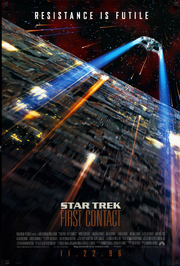
The teaser poster for Star Trek: First Contact
With the success of Star Trek Generations and its worldwide gross of US$120,000,000, [1] Paramount Pictures development executives approached producer Rick Berman in February 1995 to ready the next installment in the Star Trek franchise. During an impromptu meeting with writers Ronald D. Moore and Brannon Braga , Berman revealed his interest in a time travel story.
The Moore/Braga writing team, however, wanted to tell a story focusing on the Borg. Moore recalled the first meeting:
Brainstorming sessions began between the writer/producers' day jobs on Star Trek: Deep Space Nine and Star Trek: Voyager . Again, Moore recalled:
Though other time periods in history including the American Civil War were bandied about, eventually the Italian Renaissance time period was seized upon. An early story draft entitled Star Trek Renaissance expanded upon this idea. According to Moore, the story would have found Picard and company searching history for a group of time-traveling Borg. Happening upon a Renaissance village, the crew would hear stories about strange creatures taking over neighboring villages:
The producers realized that the time period was expensive to realize on screen, with audience knowledge of and identification with the period very low. ( AOL chat , 1997 )
Ultimately, a time period after modern history was selected: The birth of the Federation. According to Brannon Braga:
A revised storyline was constructed, this time called Star Trek Resurrection . Utilizing elements laid into place by Gene Roddenberry 's original concepts for the Star Trek universe and the Star Trek: The Original Series second season episode " Metamorphosis ", Resurrection closely resembled the final film. In the story, the Borg attack Zefram Cochrane's Montana laboratory, severely injuring the scientist. With Doctor Crusher fighting to save Cochrane's life, Captain Picard assumes his place in history, rallying a town around reconstructing the damaged warp ship. As the action unfolded, Picard would have become romantically involved with a local photographer and X-ray technician named Ruby, who helps the captain reconstruct a key element of the ship. Aboard the Enterprise , Commander Riker would be engaged in combat with invading Borg drones. The Borg in Resurrection would remain faceless automatons.
With a draft of Resurrection sent to studio executives, generally positive notes were returned. However, one Paramount executive pointed out the weakness of the Borg as being that they were "basically zombies." Despite the Borg's inception as a faceless swarm, the writers chose to incorporate a figurehead into the Collective. The Borg Queen was created, a logical extension of the insect-like qualities incorporated into the Borg's characterization. Having read the early script pages too, Patrick Stewart, however, was dissatisfied with the film. Stewart suggested that the Picard and Riker stories be switched. Thus, the focus of the film was transferred to the action aboard the Enterprise with a B-story on the planet's surface. Elements like Ruby the photographer and an injured Cochrane were ultimately scrapped. As was any prospect of a love affair for Picard. Ronald D. Moore described the thought process:
With that adjustment in the structure of the film, Berman suggested the addition of a holodeck sequence: The "cocktail party". In August 1995 an early draft of the script, still titled Resurrection , was circulated to key members of the production staff, headed by Martin Hornstein and Peter Lauritson . Using this script, the production heads would budget the film, ultimately falling into the US$45,000,000 range. [2]
Key positions were filled as preproduction began. With several members of the cast volunteering for the director's chair, Jonathan Frakes won out. According to Frakes, the film was offered to A-list directors who had little interest in the franchise; as a result he was offered the job "a month later than would have been ideal." Frakes appointed Jerry Fleck , [3] a veteran of Star Trek: The Next Generation , as first assistant director and John W. Wheeler as editor. [4] Veteran costume designer Deborah Everton was assigned the task of creating all non-Starfleet clothing, plus redesigning the Borg with Michael Westmore . Everton's credits at the time included The Abyss and The X-Files TV series; she later costumed Ronald D. Moore's Battlestar Galactica miniseries. [5] Robert Blackman returned to once again redesign the Starfleet uniforms , this time to complement Frakes' darker color palette and stand up better to big screen scrutiny.
Pre-production [ ]
The new enterprise [ ].

John Eaves' so-called "chicken in a pan" design
Upon delivery of the script to production designer Herman Zimmerman , the art department's first task was the creation of a new Enterprise . Having been retained from his work on Generations , illustrator John Eaves operated in conjunction with Zimmerman to develop the Enterprise -E, based upon direction by Berman and the writers. According to Ronald D. Moore, " We described the new Enterprise in some detail. We said we want a sleeker look, with more of a muscular, almost warship kind of a look to it. "
According to illustrator Eaves, the process began by reviewing what came before, specifically Bill George 's USS Excelsior from Star Trek III: The Search for Spock . Over twenty or thirty sketches, the designer honed the look of the ship into an even sleeker design, rotating the oval-shaped saucer of the USS Enterprise -D to fit the new concept.
By October 1995 , Eaves and Zimmerman proceeded with their design with approval from Rick Berman. Featuring the same basic shape that appears in the finished film, this version of the Enterprise -E included movable warp pylons recalling the starship USS Voyager . Showing a dorsal-view sketch to a member of the production staff, Eaves received negative feedback that compared the ship to a chicken. " …From the moment he said that, the design was cursed. Every time I looked at it, I saw not a starship, but a chicken in a pan. Sadly, Herman saw it, too, so we had to (pardon the pun) scratch that one. "
Over the next several months, the ship was again refined. In sketches dated January 1996 , the Enterprise -E had finally been settled upon. Now distinguished by back-swept engine pylons, the ship was almost ready to be constructed. Eaves described the next steps:

Eaves' finalized overview drawings for the Enterprise -E
With several days of sketching alternatives behind him, Eaves returned to his original design to focus on the smaller details that allowed Sternbach to complete his plans. By the spring of 1996 , the ship's blueprints were turned over to Industrial Light & Magic 's model building team under John Goodson . The ten-foot model was fabricated under extreme time constraint (about half the normal time period); with photographs of rooms and people inserted into the ship's windows. A computer-generated model was also constructed (with almost indistinguishable differences between the two). [6]
Interiors [ ]
Working simultaneously on the exterior Enterprise -E, Eaves and Zimmerman focused inward, generating drawings of the Enterprise bridge as early as November 1995 . First designing a smaller space to fit with the smaller, sleeker direction of the Enterprise , the art department eventually opened the set up, creating a space that was larger than the bridge of the Enterprise -D. Eaves described the decision:

The bridge of the Enterprise -E as seen on film
A collaborative process, Eaves received input from Doug Drexler regarding his new bridge:
The final details of the bridge were honed through early 1996, alongside other new sets including new corridors and an expanded engineering. Again designed by Eaves and Zimmerman, Enterprise -E corridor sets were constructed in a basic horseshoe shape with built-in handrails, back-lit monitors and removable panels that could be easily swapped for "Borgified" parts. Two lighting schemes were created for the corridor sets for normal and " red alert " conditions, though the former was not seen until Star Trek: Insurrection . For the evacuation sequence, set decorator John M. Dwyer created vacuum-formed pieces molded from the hood of a Camaro, to be used as escape pod hatches. Paramount's Stages 14 and 15 housed the vast corridor complex which connected to Herman Zimmerman's and Nancy Mickleberry's main engineering. Eaves recalled the experience:

Corridor sets under construction
Despite the number of new sets created for the film, the production once again reused old material, including turbolift wall sections dating back to 1979 's Star Trek: The Motion Picture . Sections of the starship Voyager from Star Trek: Voyager were cannibalized for the film, as filming was to take place between that series' second and third seasons. Voyager 's sickbay was repainted and redressed for use as Doctor Crusher's sickbay, and the Voyager cargo bay set became the Enterprise weapons locker with relatively little modification. Having been saved from the wrecking crews following the completion of Generations , the Enterprise -D observation lounge, first built in 1987 for Star Trek: The Next Generation was put into service, overhauled and expanded, then connected to the bridge set. For the first time in the Star Trek film series, the transporter room did not appear. Also omitted from the finished picture, a large, cylindrical fish tank constructed for Picard's new ready room was replaced with nondescript objet d'art before the cameras rolled.
It was not only from previous Star Trek productions, the movie scavenged set pieces from as Production Illustrator John Eaves divulged in 2009, " We did Osiris immediately after Generations and both were Paramount films. When First Contact was starting up we brought over all the sets from Osiris and incorporated them into Star Trek . It was an oddity to take elements I had drawn for OC and then redraw them into the TNG world…everything came together well and if you have seen Osiris or (Battle lords) the tub shaped set piece that the Plentum was in became the center piece of the Warp core of the Enterprise E. " [7] Eaves was referring to the planned science fiction television series The Osiris Chronicles , for which a pilot episode, " The Warlord: Battle for the Galaxy ", was produced in 1995/1996. A somewhat ill-conceived attempt to further capitalize on the new found popularity of science-fiction television shows, the series was not picked up however.
The Borg [ ]
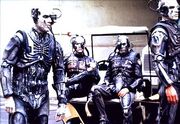
A little less menacing: the Borg relax off camera
Assigned to refresh the Borg make up that had previously consisted of simple pale faces and cobbled together bodysuits, Deborah Everton and Michael Westmore cooperated with Herman Zimmerman and his team. As late as January of '96, pages of Borg designs flowed from the art department, with contributions by Alex Delgado of Star Trek: Deep Space Nine . Working for Disney in addition to Star Trek , Delgado often worked on his time off, generating complex and sometimes grotesque images of the Borg, heavily influenced by insect life and ancient Egyptian culture. While many of Delgado's ideas (including exposed organs and obelisk-shaped vessels) were ultimately rejected, much of his work was integrated into Everton's and Westmore's final designs. According to Westmore:
What resulted were eight Borg body-suits that would be combined with individually molded pieces to be swapped into various configurations representing different drones.
Electronics built into the Borg suits often included blinking lights that spelled out production members' names in Morse code . Makeup effects were achieved by airbrushing tiny "wires" that would appear to be just below the surface of the Borg drones' skin; a wide variety of humanoid and alien drones were created, including Klingons, Cardassians and Romulans , though the latter two never appeared in the theatrical cut. With days beginning as early as 2 am, it took the makeup department thirty minutes to get the eight Borg actors into their costumes, another five hours to apply makeup, and ninety minutes to remove the makeup at the end of the day. According to Westmore:

Alice Krige as the Queen's torso, lowered on a crane
As the leader of the horde of eight, Alice Krige 's Borg Queen costume was unique. A tight-fitting, one piece bodysuit, combined with a large headpiece and integrated lighting systems, the first of the Queen's costumes was built out of hard rubber. After the first of Krige's ten-day shoot, the actress suffered from blisters raised by the tight rubber. A second, soft foam suit was fabricated overnight. Despite the relative comfort of the new suit, Krige was still required to wear painful silver contact lenses that could be worn for only four minutes at a time. According to Jerry Fleck, the actress never complained.
Borg vessels were handled by John Eaves, based upon script pages, referring to a "tetragon", or rectangular-shaped vessel. Eaves generated drawings in January 1996, labeled "Borg tetragon":
Unable to reuse the Borg cube built for the television series, created out of inexpensive pieces from model kits, a new cube had to be designed. Described by Eaves as "nonsensical", a distinctly new surface was designed, distinguished by interlocking shapes and angles, with a hidden hatchway for Eaves' Borg sphere. Intricate details of ILM's Borg cube model were achieved through the use of recycled paper clips.
Besides several background and stunt performers who changed into Borg, there were also a few Borg mannequins. One of these mannequins was sold off on the It's A Wrap! sale and auction on eBay. [8]
The Phoenix [ ]
In their original concept of Zefram Cochrane's warp ship, the Phoenix , Moore and Braga's script referred to a space shuttle-type lander , constructed on a large, outdoor platform. Difficult to realize without the aid of extensive digital effects, the production searched for more practical methods. Rick Berman ultimately seized upon the idea of utilizing a real nuclear missile, inspiring the writers to adjust the script to accommodate the "irony" of a weapon of mass destruction used to "inaugurate an era of peace."
With the cooperation of the United States military, the production gained permission to shoot within a real missile silo in Green Valley, Arizona, near Tucson. Utilizing the real, though hollowed out Titan II missile still in its silo, the team resolved to construct a new nose to sit atop the missile, acting as the cockpit of the Phoenix . John Eaves:

Eaves' approved Phoenix logo
Completing his design for the full-size cockpit facade, Eaves next began conceptualizing the second-stage Phoenix , basing his drawings on designs appearing in Michael Okuda's Star Trek Chronology . Incorporating Star Trek: The Original Series -style warp nacelles into his drawings, Eaves refined the Phoenix from rough drawings to finalized designs over months. Turning over the plans to ILM and John Goodson's team, Eaves was stunned by the finished product:
Though mostly invisible on screen, a logo for Cochrane's warp ship was also designed by Eaves on the fly.
Calling a number of gift shops in the area, Eaves was finally able to locate a postcard with an appropriate picture of the phoenix he remembered. Taking the postcard to a local store, the gift shop owner faxed a picture of the phoenix to the Paramount production offices where Eaves went to work. With only a single pass, the logo was approved by Rick Berman.
Production [ ]
In the spring of 1996, newly-recruited director Jonathan Frakes and producer Rick Berman cast their three "guest stars". Two-time Academy Award winner Tom Hanks, an admitted Trekker, was slated to play Zefram Cochrane but he was busy with his directorial debut. The role went to James Cromwell , a veteran of Star Trek: The Next Generation and Star Trek: Deep Space Nine , and Oscar nominee for his role in the 1995 movie Babe . According to Jonathan Frakes: " In spite of having been nominated for an Academy Award, he actually came in and read for the part… He nailed it. He left Berman and me with our jaws in our laps. " Cromwell later reprised his role as Cochrane in the Star Trek: Enterprise first season episode " Broken Bow ".

Robert Picardo cameos as another EMH
For the role of Lily, Frakes' immediate inclination after reading the script was to cast actress Alfre Woodard . Woodard, an Oscar nominee herself and multiple Emmy Award winner, was Frakes' self-proclaimed "godmother": " The first time we got through the script, I think everyone's first words were 'Alfre Woodard'. " A challenge for Frakes and Berman, though, was ultimately solved in the casting of South African-born actress Alice Krige as the Borg Queen. Both Frakes and the Moore/Braga writing duo would later recall a sense of uneasy sexiness in Krige's portrayal of the Queen, aided by the application of a wet sheen to her skin by the make up department. Other guest players were added to the Resurrection call sheets as they were added to the script, including Trek vets Dwight Schultz as Barclay , Ethan Phillips as the holographic maitre'D , and Robert Picardo as the EMH of the Enterprise -E (not to be confused with The Doctor ). Phillips' role went uncredited, a request made by the actor to confuse fans who may or may not recognize him from his role as Neelix .
Other cast additions included Patti Yasutake 's final appearance as Nurse Alyssa Ogawa, having first appeared back in TNG's fourth season . Don Stark was cast as Nicky the Nose , most memorable in his role as Bob Pinciotti in TV's That '70s Show – he also appeared in the Star Trek: Deep Space Nine second season episode " Melora " as Ashrock the Yridian . Jack Shearer appears as Admiral Hayes, later reprising the role (Hayes apparently escaping the destruction of his ship) in Voyager episodes " Hope and Fear " and " Life Line ". Actor Eric Steinberg portrayed Paul Porter , taken early in the film but appearing throughout as a partially assimilated Borg drone in engineering.
Brannon Braga is clearly visible as an extra in the holodeck nightclub as the Borg enter the scene, though writing partner Moore's appearance was never shot – despite sixteen hours of waiting with his then wife Ruby, an anniversary present. Rumors persist ( citation needed • edit ) that both Nichelle Nichols and Kelsey Grammer (captain of the USS Bozeman from " Cause And Effect ") have uncredited "voice cameos", though these claims are unsubstantiated.
Production on Star Trek Resurrection began on 8 April 1996 , but within a month, a new title had been chosen. Mere weeks prior, 20th Century Fox had announced the title of the fourth installment in their Alien film franchise: Alien Resurrection . A number of new titles were proposed for the film including Star Trek Destinies , Star Trek: Future Generations , and Star Trek Regenerations . The titles Star Trek: Borg and Star Trek Generations II were even chosen as working titles for the film until Star Trek: First Contact was finally selected, made official in a 3 May 1996 fourth draft script. ( Star Trek: Borg went on to become the title of a video game, released not long after.)
"The line must be drawn here!" : A pivotal scene
Minor details in the script, even as shooting was under way, continued to evolve. Early drafts were vague regarding the fate of the Defiant , DS9's resident warship. Having read the script, Deep Space Nine producer Ira Steven Behr 's only note was an objection to the apparent destruction of the Defiant . The writers added the clarification "adrift but salvageable" and no mention of the ship's near annihilation was made in the TV series. Minor details in the script's pages included the ill-fated Enterprise crew member Ensign Lynch , named after a friend of writer Brannon Braga, but thought by many named for Internet critic Timothy W. Lynch, who reviewed every episode of TNG and DS9. Gravett Island was not a real Earth location, but a fictional one named after Jacques Gravett, Ronald D. Moore's then assistant. Rumors circulated during production, even reported by some LGBT publications, that another ill-fated Enterprise crewman, Neal McDonough 's Lieutenant Hawk was gay. No reference is made in the finished film to this fact; the producers have denied the rumors. [9] Regarding the film's emotional battle played out between Picard and Lily, Brannon Braga recalled: " I'd have to say that scene was nailed and perfect only about a week before it was filmed. " ( citation needed • edit )
Location shooting dominated the early schedule for the Star Trek: First Contact production team. First up were scenes set in Bozeman, Montana, shot in the Titan Missile Museum outside Tucson, Arizona for a duration of four days. The production then moved to the Angeles National Forest in the San Gabriel Mountains not far from Los Angeles. Two weeks of nighttime shooting followed, with a large village constructed by Herman Zimmerman's art department to represent exterior Bozeman. Minor details in the sets included the 52-star American flag referencing an early TNG episode, " The Royale ". A full-size section of the Vulcan lander was brought to this location for the film's finale. The film then moved to Los Angeles Union Station's art deco restaurant where the Dixon Hill holonovel sequence played out, including over 120 extras in period costumes and two Borg drones. Everton designed the costumes for Picard, Ruby, Sloane, and the other speaking parts, while many others were rented. ( Star Trek: The Magazine Volume 1, Issue 13 , p. 67)
Production finally moved to Paramount Pictures studios in Hollywood on May 3 for a half day of shooting on the three story Enterprise -E engine room set. Cameras were then moved from Stage 14 to Stage 15 where scenes were shot on the bridge, observation lounge and ready room sets. Jonathan Frakes recalled:
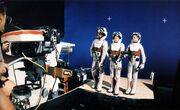
Patrick Stewart, Michael Dorn, and Neal McDonough film the "space walk" scene
The next two months were dubbed by the crew, "Borg Hell", with scenes shot on stages 14, 15 and 8 that included heavily made-up Borg extras, stunts, pyrotechnics, and one large deflector dish. Likely the film's most labor intensive sequence to shoot was the battle on the Enterprise hull, on the film's largest set. The deflector dish itself, while massive, was shot at angles intended to exaggerate its size – the manual input computers were labeled "AE35", a subtle reference to 2001: A Space Odyssey . The sequence also required Patrick Stewart as Picard, Michael Dorn as Worf, and Neal McDonough as Hawk to wear restrictive environmental suits that incorporated internal lighting and cooling systems. With the addition of flying rigs and complex stunts, tempers on the set were pushed, as was Patrick Stewart's endurance; the actor suffered breathing problems in his spacesuit, halting production for an entire day. Problems also arose in the realism of the sequence, with smoke rising from the set, then quickly falling, contrary to the physics of real life zero-G. This required Frakes to shoot around the smoke, or shoot takes short enough to prevent the falling smoke to be seen. Writers Moore and Braga agreed that, had the film been produced only a few years later, the entire sequence was likely to have been less complicated if shot with computer-generated sets.
Despite the complications, Star Trek: First Contact wrapped production on 2 July 1996 (two days over schedule), with the flashback that opened the film. Fittingly, the sequence required Patrick Stewart to don the Starfleet uniform he had worn for at least five of the seven seasons on Star Trek: The Next Generation . According to Ronald D. Moore, everyone involved with the film knew it was going to be a hit.
Production history [ ]
- 8 January 1996 – Second draft script, titled Star Trek: Resurrection
- 12 March 1996 – Third draft script, titled Star Trek: Borg
Post-production [ ]
Visual effects [ ].
As described by visual effects supervisor John Knoll , time allotted for post production visual effects and model building resulted in a "brutal effort". Not only did ILM's team have to construct the Enterprise -E, large models representing the Borg sphere, the new Borg cube, and the Phoenix were also required.
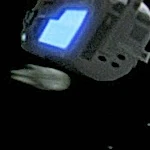
The Millennium Falcon appears below an Akira -class starship
Even more so than the previous film, the First Contact visual effects team also utilized computer-generated imagery, lending itself to sequences that required large numbers of starships. To stand up to the Borg cube alongside the new Enterprise and the old Defiant , ILM art director Alex Jaeger designed sixteen new Starfleet vessels, four of them rendered digitally and appearing in the massive opening battle sequence. The new starships included Akira -class , Saber -class , Steamrunner -class , and Norway -class vessels; the latter starship was lost after production due to a computer glitch, never to appear in Star Trek again. Also included in the melee were a Nebula -class starship, a Miranda -class vessel, and an Oberth -class science ship in its final use. As a joke, the Millennium Falcon CG model (created for the Star Wars Special Editions) was inserted into the Borg attack, though generally indistinguishable.
Other computer-generated vessels included the John Eaves' designed Enterprise escape pods and the Vulcan lander, constructed by the VisionArt company. At that time, First Contact included more complex visual effects shots than any Star Trek film before; low-tech methods, however, were still utilized. Close-up shots of La Forge's new ocular implants were achieved through the use of a sprocket-shaped shower handle, matted against black contact lenses.
Jerry Goldsmith , who composed the music for Star Trek: The Motion Picture and Star Trek V: The Final Frontier , returned to score First Contact and the remaining two TNG films after it. Because of his hectic schedule, Goldsmith shared much of the work with his son, Joel Goldsmith; as a result much of the music in First Contact does not appear on the commercial soundtrack.
Among the two Goldsmiths' work, a theme established in The Final Frontier , referred to as the "A Busy Man" theme, was used throughout First Contact , likely as a theme for Picard. It can be heard just after the opening fanfare at the beginning of the film. It can also be heard only briefly in Insurrection , but is used quite heavily in Star Trek Nemesis . Also repeated in First Contact was the Klingon theme, originally introduced in The Motion Picture and used in this film to represent Worf. As with all Star Trek films scored by Goldsmith, the theme from The Motion Picture was used in the end credits, and the opening fanfare from the Theme from Star Trek was used to segué into the opening and closing themes.
The opera that Picard listens to in his ready room is Berlioz ' Les Troyens – "Hylas' Song" from the beginning of Act V. (Hylas is a homesick young sailor being rocked to sleep by the sea as he dreams of the homeland he will never see again.) This is the first and only Star Trek movie to have rock and roll in the soundtrack (though Star Trek IV: The Voyage Home did feature late '80s jazz by the Yellowjackets, as well as a punk song , and Star Trek , Star Trek Into Darkness , and Star Trek Beyond all included hip hop songs – all three featured songs by the Beastie Boys , and Star Trek Beyond also included a song by Public Enemy ). In their joint audio commentary on the Special Edition DVD, Ron Moore and Brannon Braga credited Peter Lauritson with the selection of Steppenwolf 's original recording of "Magic Carpet Ride" (and not "some cheap cover"). They criticized, however, the choice of Roy Orbison 's " Ooby Dooby " as being "too goofy".
Promotion and merchandising [ ]

A shot of Voyager created for the First Contact teaser

Borg from a cut scene appearing in the trailer
The teaser trailer for Star Trek: First Contact premiered with Paramount movies in early summer 1996. As much of the film had yet to be shot when the advertisements were assembled, footage from Star Trek Generations and episodes from Star Trek: The Next Generation and Star Trek: Deep Space Nine was included. Inter-cut with sequences from the film, the reused footage included snippets of " The Best of Both Worlds " and " Emissary ". The trailer utilized score from "The Best of Both Worlds", Generations , and Star Trek II: The Wrath of Khan , most notably, however, from Star Trek VI: The Undiscovered Country .
Both the teaser and theatrical trailers included footage unique only to them, with some visual effects created specifically for the trailer. Unique shots included the USS Voyager firing phasers at a differently-designed Borg cube and an alternate version of Picard's soon-to-be infamous speech, " The line must be drawn here! " in the teaser, and cut takes of various Borg drones in the theatrical. [10]
As with the previous film and TNG, Playmates Toys released a line of action figures and accessories in conjunction with the premiere of the film. Among the toys was a model of the Enterprise -E, apparently based upon early sketches of the ship and not the finalized version – featuring several key structural differences from the finalized design. Out of scale to their previous lines, the larger First Contact action figures were made in the likenesses of the entire Enterprise -E crew, Lily, Zefram Cochrane, Picard in an environmental suit, and a Borg drone – also based on production drawings. [11] In recent years, Art Asylum has released a detailed action figure in the likeness of Captain Picard from First Contact , complete with the skull of the Borg Queen.
Marvel Comics released both a comic adaptation of the movie, and a sequel comic book that crossed the crew with the X-Men in " Second Contact ". This had a later sequel novel by Michael Jan Friedman , called Planet X .
First Contact novelizations and soundtracks were also released, as were updated versions of the Star Trek Chronology and Star Trek Encyclopedia .
Box office performance [ ]
Star Trek: First Contact premiered in American cinemas on 22 November 1996 , number one at the box office. With a budget of around US$45,000,000, it opened nationwide on 2,812 screens at US$30,716,131 and went on to eventually garner US$146,027,888 worldwide. [12] By comparison, Star Trek Generations , with a budget of US$35,000,000, opened at US$23,116,394 on 2,659 screens, but only grossed US$118,071,125 worldwide. [13] It made First Contact the highest grossing Star Trek film ever, surpassing the hitherto highest grossing film 1986 's Star Trek IV: The Voyage Home – though it remained the second-most profitable one after Star Trek II: The Wrath of Khan – until the release of 2009 's Star Trek and its two sequels.
In the United Kingdom, despite becoming the first Star Trek movie not to reach the top of the box office since The Wrath of Khan , the film was a success earning £3,555,980 for its opening weekend and £8,735,340 overall. It was the highest grossing Star Trek film overall in that territory until the release of Star Trek . [14]
The film, however, was considered by most to be not only a financial success, but a critical one as well, beating out both The Wrath of Khan and The Voyage Home respectively in this regard, as of 2020 only to be surpassed by 2009's Star Trek by the slimmest of margins.
Reactions [ ]
The film review website Rotten Tomatoes calculated a 92% critic score for First Contact , with 40 of 44 reviews giving positive remarks. [15] Giving the film "Two thumbs up!", Siskel & Ebert host Roger Ebert elaborated in his Chicago Sun Times review:
While often negative in his reviews of other Trek films, Ebert elaborated, " how I love the Star Trek jargon! " and even expressed his fondness for the Borg Queen:
BBC Films' Emily Carlisle, however, was less enamored:
In his 18 November 1996 review, Daily Variety magazine writer Joe Leydon expressed his approval:
Leydon concluded, " If First Contact is indicative of what the next generation of Star Trek movies will be like, the franchise is certain to live long and prosper. " [18]
- This film opened on the same day that Mark Lenard , the actor best known for portraying the character of Sarek , died at the age of 72.
- Despite the use of the uniforms in the previous film, Star Trek Generations , this is the only movie starring The Next Generation cast where the Star Trek: The Next Generation and early Star Trek: Deep Space Nine combadge is seen, as visible on Picard's uniform in the flashback from " The Best of Both Worlds " in the opening of the film.
- The reference that Data makes about using his "fully functional" sexual organs seemingly references the time he used them with Tasha in TNG : " The Naked Now ", eight years before the Borg invasion (though that would place that episode in 2365 ). This would seem to indicate Data and his fourth-season "girlfriend" Jenna D'Sora were never sexually intimate during the course of their relationship.
- This film marks the first canon reference to the number of planets in the Federation (over 150) and its size (over 8,000 light years)
- The bar in Bozeman featured bar signs based on mission patches for NASA vessels, including the Molly Brown .
- First Contact references and even explicitly quotes Moby Dick . Despite the story parallels, the producers hesitated using it, as Star Trek II: The Wrath of Khan was also heavy in Moby Dick references. Two years after First Contact premiered, Patrick Stewart played Captain Ahab in a 1998 TV mini-series.
- However, Picard slightly misquotes the Moby Dick passage. The actual passage is " He piled upon the whale's white hump the sum of all the general rage and hate felt by his whole race from Adam down; and then, as if his chest had been a mortar, he burst his hot heart's shell upon it. "
- Early in the movie, Zefram Cochrane points out the constellation Leo, the constellation in which Wolf 359 is located.
- First Contact marked the first time the phrase "star trek" was ever uttered in the franchise. In the TNG finale " All Good Things... ", however, Q tells Picard " It's time to put an end to your trek through the stars . "
- When Picard announces to the crew his intention to break his orders and join the engagement, Data's response is " Captain, I believe I speak for everyone here sir when I say, 'To hell with our orders'. " Similarly in Star Trek VI: The Undiscovered Country , Spock's response to the Enterprise 's orders to return to spacedock is " If I were Human, I believe my response would be, 'Go to hell'. "

The different holodeck programs on the Enterprise -E
- The program menu in the holosuite depicts various holodeck programs from previous episodes, specifically Café des Artistes , ( TNG : " We'll Always Have Paris ") Charnock's Comedy Cabaret , ( TNG : " The Outrageous Okona ") The Big Goodbye , ( TNG : " The Big Goodbye ", " Manhunt ", " Clues ") Emerald Wading Pool , ( TNG : " Conundrum ") and the Equestrian Adventure . ( TNG : " Pen Pals ")
- Picard's line " Reports of my assimilation have been greatly exaggerated " is a paraphrasing of a famous quotation by Mark Twain , concerning his premature obituary. Picard had made a similar paraphrasing in TNG : " Samaritan Snare " (" Any rumors of my brush with death are greatly exaggerated ").
- Riker calls the Defiant a "tough little ship." In the DS9 third season episode " Defiant ", Thomas Riker called it the same thing.
- According to the (apocryphal) Customizable Card Game by Decipher , the Vulcan who greeted Zefram Cochrane was named Solkar , the grandfather of Sarek and the great-grandfather of Spock . This was later supported by dialogue in ENT : " The Catwalk ".
- The events of Star Trek: First Contact were later referred to in DS9 : " In Purgatory's Shadow ", VOY : " Year of Hell, Part II ", and VOY : " Relativity ", the latter using those events as an example for the Pogo paradox . The Borg sphere was recovered in ENT : " Regeneration ", while a slightly different version of Earth's first contact with Vulcans – utilizing footage from the film – can be seen in ENT : " In a Mirror, Darkly ".
- According to ENT : " Carbon Creek ", though this movie records the first official contact between Earth and Vulcan, contact was actually made in 1957 in a place called Carbon Creek , Pennsylvania , nearly 110 years prior.
- Subsequent Vulcan starships seen in Star Trek: Enterprise were based upon the T'Plana-Hath -type lander seen in this movie.
- Geordi La Forge , who with Riker participates in Cochrane's historic first warp flight, had earlier compared being at Bilana III to view the soliton wave experiment to being present when Cochrane engaged the first warp drive in TNG : " New Ground ".
- According to DS9 : " The Search, Part I ", the Defiant had originally been designed to counter the Borg threat, but was then assigned to Deep Space 9 . The Battle of Sector 001 was the only time the Defiant eventually battled the Borg.
- The model of the USS Enterprise (NCC-1701) that was on display in the conference room was auctioned off (albeit broken) in the It's A Wrap! sale and auction .
- Lily says that "Borg" sounds Swedish. In Swedish, "borg" actually means "castle", although it would be pronounced as "borj". "Borg" is also a Swedish surname. In addition, the word is spelled and means the same in Norwegian and Danish, and in these cases is pronounced very similar to the English word. The most well-known "Borg" is the internationally-known Swedish tennis player Björn Borg .
- This marks the fourth of five times the captain shows a female native her home planet from orbit. This happened previously with Rivan in " Justice ", Nuria in " Who Watches The Watchers ", and Mirasta Yale in the episode " First Contact ", and later with Bethany in " North Star ". This approach clearly has meaning to the captain as he tells Anij in Star Trek: Insurrection , seeing his home planet from space for the first time was a moment when time stood still.
- Besides making references to Moby Dick, this film is also similar to The Wrath of Khan in that they're both sequels to classic episodes of their respective series; TWOK follows " Space Seed " while FC follows " The Best of Both Worlds " and " The Best of Both Worlds, Part II ".
- Among the items seen in this film which were sold off on the It's A Wrap! sale and auction on eBay are the Phoenix Launch Silo Missile Manual , [19] a broken model of the USS Enterprise -D , [20] a broken model of the USS Enterprise -C , [21] a pair of boots worn by a background actor, [22] a Phoenix button board, [23] and an undersuit of Alice Krige . [24]
- This movie includes one of the explicit mentions of the attributes of the New World Economy . Picard tells Lily that money (as she understands it) no longer existed in the 24th century, and that people worked not for the acquisition of wealth, but for the betterment of all Humanity.
- In the Star Trek: Deep Space Nine episode " In the Cards ", Jake Sisko repeats Picard's line " we work to better ourselves and the rest of Humanity, " only to be challenged by Nog saying, " What does that mean, exactly? " Similarly, in DS9 : " The Dogs of War ", Quark speaks almost the same words (" The line has to be drawn here! This far and no further! ") as Picard does during Star Trek: First Contact . The two episodes were, respectively, written and co-written by Ronald D. Moore, who also co-wrote First Contact . Said Moore, " I take great glee at mocking my own work. " ( AOL chat , 1999 )
- Based on averaging the differences of the stardates from Star Trek: Deep Space Nine 's " Children of Time " and " Empok Nor ", the initial events of this film should have occurred between " Blaze of Glory " and " Empok Nor ". However, Sisko 's mention of " the recent Borg attack " in " In Purgatory's Shadow ", actually places First Contact before that episode. Furthermore, based on the stardates, the initial events of the film would have taken between the events of the Star Trek: Voyager episodes " Real Life " and " Displaced ". It is unclear whether these events take place before, after or contemporaneously with the events of " Distant Origin ", which was broadcast in the interim and does not feature a stardate.
- In the ending credits, Zefram Cochrane 's name is misspelled as "Zefram Cochran".
- This is the only Star Trek movie to feature a female primary antagonist, the Borg Queen .
- This film is the only appearance of the Defiant outside of Star Trek: Deep Space Nine .
- It is the first Star Trek film to be rated PG-13.
- This was the first Star Trek film since The Motion Picture to not re-use any footage from previous films.
- This is the only Star Trek film not to feature scenes on a planet other than Earth.
- This was the first of two Star Trek films ( Star Trek Into Darkness being the other) to be given a certification during the end credits by the American Humane Association that no animals were harmed during the film's production.
- The new Starfleet uniforms , which were introduced in the film, would later be adopted in the Star Trek: Deep Space Nine episode, " Rapture " onward, but the crew on Star Trek: Voyager continued to use the old DS9 Starfleet uniforms , due to being stranded in the Delta Quadrant .
Apocrypha [ ]
The novelization of Star Trek: First Contact establishes that during the Battle of Sector 001 as the Defiant attacked the Borg Cube, Worf thought that by keeping the Enterprise away from the battle, Starfleet Command was doing Picard a great dishonor by not allowing him the opportunity to gain revenge against his mortal enemy.
In Oblivion's Gate , the third and final novel of the Star Trek: Coda trilogy, it was revealed that Captain Picard and the crew of the Enterprise -E caused the creation of the First Splinter timeline during their attempt to stop the Borg from assimilating Earth in the year 2063, and the Devidians used this to their own advantage as part of the Temporal Apocalypse.
Merchandise gallery [ ]
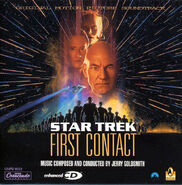
Awards and honors [ ]
Star Trek: First Contact received the following awards and honors.
Links and references [ ]
Credits [ ], opening credits [ ].
- Patrick Stewart
- Jonathan Frakes
- Brent Spiner
- LeVar Burton
- Michael Dorn
- Gates McFadden
- Marina Sirtis
- Alfre Woodard
- James Cromwell
- Alice Krige
- Junie Lowry-Johnson , CSA and Ron Surma , CSA
- Jerry Goldsmith
- Peter Lauritson
- Deborah Everton
- John W. Wheeler , ACE
- Herman Zimmerman
- Matthew F. Leonetti , ASC
- Martin Hornstein
- Gene Roddenberry
Rick Berman
Rick Berman & Brannon Braga & Ronald D. Moore
Brannon Braga & Ronald D. Moore
Closing credits [ ]
- Jerry Fleck
- Rosemary Cremona
- Picard – Patrick Stewart
- Riker – Jonathan Frakes
- Data – Brent Spiner
- Geordi – LeVar Burton
- Worf – Michael Dorn
- Beverly – Gates McFadden
- Troi – Marina Sirtis
- Lily – Alfre Woodard
- Zefram Cochran – James Cromwell
- Borg Queen – Alice Krige
- Security Officer – Michael Horton
- Lt. Hawk – Neal McDonough
- Eiger – Marnie McPhail
- Holographic Doctor – Robert Picardo
- Lt. Barclay – Dwight Schultz
- Defiant Conn Officer – Adam Scott
- Admiral Hayes – Jack Shearer
- Porter – Eric Steinberg
- Security Officer – Scott Strozier
- Nurse Ogawa – Patti Yasutake
- Victor Bevine ( Guard #1 )
- David Cowgill ( Guard #2 )
- Scott Haven ( Guard #3 )
- Annette Helde ( Guard #4 )
- Computer Voice – Majel Barrett
- Bartender – C.J. Bau
- Ruby – Hillary Hayes
- Singer in Nightclub – Julie Morgan
- Henchman – Ronald R. Rondell
- Nicky the Nose – Don Stark
- Vulcan – Cully Fredricksen
- Townsperson – Tamara Lee Krinsky
- Don Fischer ( Bolian drone )
- J.R. Horsting
- Heinrich James
- Andrew Palmer ( Romulan drone and Non-Romulan drone )
- Jon David Weigand
- Robert L. Zachar ( Borg #3 )
- Ronald R. Rondell
- Kenny Alexander
- Janet Brady
- Chic Daniel
- Kenny Endoso
- Christian Fletcher
- Frankie Garbutt
- Andy Gill (Stunt double for Brent Spiner )
- Gary Guercio
- Rosine "Ace" Hatem ( Nightclub patron )
- Billy Hank Hooker
- Buddy Joe Hooker
- Maria Kelly ( Nightclub patron )
- Jamie Keyser (Stunt double for Alice Krige )
- Kim Robert Koscki (Stunt double for Ethan Phillips )
- Joyce McNeal
- Dustin Meier
- Johnny C. Meier
- Rita Minor (Stunt double for Alfre Woodard )
- Jimmy Nickerson
- John Nowak (Stunt double for Patrick Stewart )
- Manny Perry ( Bozeman townsperson )
- Steve Picerni
- Danny Rogers
- Jimmy Romano
- Debby Lynn Ross
- John Rottger
- Craig Shuggart
- Brian J. Williams (Stunt double for Brent Spiner )
- Joey Anaya, Jr.
- Billy Burton, Jr.
- Steve DeRelian ( One Armed Drone )
- Gary Epper ( Ensign Lynch )
- Tom Harper ( Drone Protecting Engineering )
- Wayne King, Jr. ( Assimilated Klingon )
- Bob McGovern
- Monty Rex Perlin
- David Takemura
- Michael Westmore
- Joel Goldsmith
- Robert Blackman
- Ron Wilkinson
- John M. Dwyer
- Michael Okuda
- Les D. Gobruegge
- Nancy Mickleberry
- Martha E. Johnston
- William P. Hawkins
- Linda A. King
- Joseph Musso
- Ricardo Delgado
- Ivan "Bing" Sokolsky
- David Lukenbach
- Randy Feemster
- Michel D. Weldon
- Mark Santoni
- Paul Santoni
- Elliot S. Marks
- Wayne Tidwell
- Patrick R. Blymyer
- Tim Marshall
- Frank X. Valdez III
- Greg Cantrell
- Christopher Lama
- Lloyd Barcroft
- Shawn Whelan
- Armando Contreras
- Anthony Mollicone
- Tino Contreras
- Alan Schultz
- John D. Babin
- Thomas Causey
- Joe Brennan
- John Agalsoff
- Terry D. Frazee
- Eugene Crum
- Greg Curtis
- Donald Frazee
- Donald E. Myers, Jr.
- Donald T. Black
- Logan Z. Frazee
- Scott Lingard
- Samuel Price
- Ralph Allen Winiger
- Scott Wheeler
- Jake Garber
- James MacKinnon
- Bradley M. Look
- R. Stephen Weber
- Sonny Burman
- June Westmore
- Monty Westmore
- Mark Bussan
- Camille Calvet
- Belinda Bryant
- Mary Kay Morse
- Todd Masters Co.
- Todd Masters
- Greg Johnson
- Jaremy Aiello
- David Matherly
- Timothy P. Huizing
- Scott D. Tebeau
- Claudia Regne
- Shanna Tebeau
- Robert W. Miller
- A.J. Venuto
- Bernhard Eichholz
- Patrick M. Gerrety
- Patrick A. Chitty
- Walter T. Phelan
- Joe Colwell
- John F. Shea
- Gloria Munoz
- Thomas D. Bacho, Jr.
- Cory Sylvester
- Alan Tuskes
- Derik Wingo
- William J. Fesh
- Thomas Zimmerman
- Brian Van Dorn
- Alexi Bustamante
- Kristine Morgan
- Michael Westmore, Jr.
- Yolanda Toussieng
- Danny Valencia
- Lee Ann Brittenham
- Chris McBee
- Barbara Ronci
- Dean Wilson
- Glen Feldman
- William K. Dolan
- Elijah Bryant
- Philip Calhoun
- James Buckley
- Denise Lynn Okuda
- Shawn Baden
- Doug Drexler
- Anthony Fredrickson
- John Josselyn
- James E. Van Over
- Elizabeth Radley
- Benjamin A. Betts
- Larry Markart
- Christine Heinz
- Leah P. Brown
- Charles Ray de Muth
- Sonny Merrit
- Heidi Strasburg
- Gina A. Flanagan
- Timothy Board
- John A. Haggar
- Travis G. Rendich
- James W. Wolvington
- Cameron Frankley
- Jeffrey Clark
- Doug Jackson
- David F.Van Slyke
- Kerry Dean Williams
- Scott G.G. Haller
- Michael Szakmeister
- Richard Corwin
- Robert Ulrich
- Pamela Bentkowski
- Tammy Fearing
- Scott Curtis
- Courtenay Marvin
- Roger Fearing, Jr.
- Robert Morrisey
- Paramount Pictures
- Randy Singer
- David Lee Fein
- Sarah Monat
- Robin Harlan
- Steve Pederson
- Brad Sherman
- Arthur Morton
- Alexander Courage
- Jeff Atmajian
- Bob Bornstein
- Sandy De Crescent
- Clifford Kohlweck
- Bruce Botnick
- Paramount Pictures Scoring Stage M
- Barbara Harris
- Smith Wordes
- Ira Stanley Rosenstein
- James Selzer
- David A. Ticotin
- David Goldfarb
- Robin Bronner
- Deborah L. Schwab
- David Rossi
- Barbara Casner
- Cindy M. Ichikawa
- Thomas J. Arp
- Frank "Ferb" Leasure
- John M. Carroll
- Clete F. Cetrone
- Curtis B. Jones
- Sammy Mendoza
- Steve Morey
- Aaron H. Rockler
- Gary A. Clark
- David R. Galvan
- Barry R. Tugendhaft
- Vincent R. Heileson
- Primrose V. Fukuchi
- Alex Worman
- Penny Juday
- Lisa J. Olin
- April Rossi
- Jackie Edwards
- Lolita Fatjo
- Robert Gillian
- Janet Nemecek
- Robert Newlin-Mazaraki
- Ellen J. Hornstein
- Eric Darensbourg
- Brenda Taylor
- Simon Stotler
- Todd W. Buhmiller
- Kerry A. Vill
- Karen Garutso
- Stephanie Gorsuch
- Anthony Bro
- Seth Squadron
- Wayne Nelson
- Kenneth Newland
- Tim Edwards
- Bruce Moore
- Kevin A. Canamar
- William "Tex" Collins
- Wescam, Inc.
- Central Casting
- Cenex Casting
- Industrial Light & Magic , a division of Lucas Digital Ltd., Marin County, CA
- George Murphy
- Alex Jaeger
- Habib Zargarpour
- Dennis Turner
- Joakim Arnesson
- Steve Braggs
- Kyeng-Im Chung
- Marc Cooper
- Mitch Deoudes
- Jeremy Goldman
- Matt Hendershot
- Stu Maschwitz
- Steve Molin
- Eric Texier
- Pablo Helman
- Chad Taylor
- Luke O'Byrne
- Heather Smith
- Bill George
- Noel Brevick
- Tad Leckman
- Chris Stillman
- Jonathan Rothbart
- Paul Theren
- Tim Alexander
- Kathleen Beeler
- Scott Frankel
- Greg Maloney
- Tom Rosseter
- Cathy Burrow
- Susan Kelly Andrews
- Heidi Zabit
- Selwyn Eddy III
- Jodie Maier
- Patrice D. Saenz
- Mike McGovern
- Mike Gleason
- Anastasia Emmons
- Ladd MacPartland
- Tim Greenwood
- Kenneth Smith
- Joshua Pines
- George Gambetta
- Todd Mitchell
- Amanda Micheli
- Jodi Birdsong
- Andrea Biklian
- Timothy Geideman
- Nancy Jencks
Motion Control and Pyrotechnics Unit [ ]
- Marty Rosenberg
- Patrick Sweeney
- Robert Hill
- John Gadzik
- Keith London
- Brad Jerrell
- Geoff Heron
- Chuck Biagio
- Berny Demolski
- David Murphy
- Adam Bennes
- David Dranitzke
- John Goodson
- Barbara Affonso
- Jon Foreman
- Rick Anderson
- Jeff Brewer
- Giovanni Donovan
- John Duncan
- Ed Miarecki
- Nancy Luckoff
- Suzie Vissotzky Tooley
- Amanda Montgomery
- Heidi Schmidt
- Anthony Pitone
- Rodney Bogart
- Jeffery Yost
- Dugan Beach
- Dan Shumaker
- Christa Starr
- Angela Leaper
- Heather McCurdy
- Patricia Blau Price
- Gail Currey
- Pacific Ocean Post Digital Film Group
- Scott Rader
- Adam Howard
- Andrea D'Amico
- Greg Kimble
- Carol Brzezinski
- Caleb Aschkynazo
- Kenneth Littleton
- Lawrence Littleton
- Jennifer German
- Brandon McNaughton
- Michael Peterson
- David Crawford
- Kirk Cadrette
- Stephane Couture
- Joshua D. Rose
- Richard J. Cook
- Daniel Kramer
- Carl Hooper
- Dorene Haver
- Bethany Berndt-Shackelford
- Jeff Pierce
- Celine Jackson
- Illusion Arts
- Robert Stromberg
- Mike Wassel
- Richard Patterson
- Fumi Mashimo
- Matte World Digital
- Craig Barron
- Krystyna Demkowicz
- Chris Evans
- Caroleen Green
- Paul Rivera
- Morgan Trotter
- Cameron Noble
- Pacific Title
- Mike Milliken
- Theresa Repola Mohammed
- Bruce Schluter Design, Inc.
- GNP Crescendo Records, CDs and Cassettes
- by Dick Penner & Wade Moore
- Performed by Roy Orbison
- Courtesy of Orbison Records, Inc.
- Music by Alexander Courage
- by Johnny Burke & James Van Heussen
- Performed by Julie Morgan
- Produced by John E. Oliver
- by Hector Berlioz
- Performed by Ryland Davies and The Orchestra and Chorus of the Royal Opera House, Convent Garden
- Conducted by Sir Collin Davis
- Courtesy of Phillips Classics by arrangement with PolyGram Film & TV Licensing
- by John Kay & Rushton Moreve
- Performed by Steppenwolf
- Courtesy of MCA Records by special arrangement with MCA Special Markets and Products
- Pima Air and Space Museum and Titan Missile Museum
- USDA Forest Service , Angeles National Forest
- Arroyo Seco Ranger District and Annitta H. Keck
- Arizona State Film Commission
- Playback Technologies
- [[Cinema Vehicle Services[[
- Jeri Taylor
- Ira Steven Behr
- Merri Howard
- Steve Oster
- Wendy Neuss
- Bill Wistrom
- Philip M. Strub
- Lieutenant Colonel Thomas R. Worsdale
- Eastman Kodak Film
Uncredited [ ]
Performers [ ].
- Al Ahlf as security officer
- David Keith Anderson as Armstrong
- Patrick Barnitt as Borg drone
- Terrence Beasor as Additional Voices
- Denise Blasor as Additional Voices
- Renna Bogdanowicz as Lopez
- Mike Boss as holographic nightclub patron ( unconfirmed )
- Harry Boykoff as Eddy
- Brannon Braga as holographic nightclub patron
- Michael Braveheart as Martinez
- Cameron as Kellogg
- Steve Carnahan as Borg drone
- Tracee Lee Cocco as Jae
- Jeff Coopwood as The Voice of the Borg
- John Copage as holographic nightclub patron
- David Paul Cutler as civilian engineer
- Kenneth David Ebling as sciences officer
- Heather Ferguson as security officer
- Kevin Finister as command crewman
- Sylvester Foster as operations officer
- Tracey Frakes as Nicky's girl #2
- Star Halm as security officer
- Noelle Hannibal as Vulcan officer
- Jon Horback as security officer
- Randy James as Jones
- Jimmy Kupenwoff as operations division officer
- Dan Magee as assimilated operations officer
- James Mapes as Buster ( deleted scene )
- Angus McClellan as | Bajoran sciences officer
- Ronald D. Moore as Holodeck Nightclub Patron
- Vulcan officer
- Ethan Phillips as nightclub maître d'
- Larry Polson as man with dog
- Woody Porter as science division lieutenant
- Jackie Rainey as operations division officer ( unconfirmed )
- Aric Rogokos as Starfleet security officer
- Shepard Ross as Starfleet security officer
- Rick Rossi as nightclub musician
- Janelle Showalter
- Steph Silvestri as Enterprise -E engineer
- Pablo Soriano as holographic nightclub patron
- Gregory Sweeney as Bolian science officer
- Chris Tedesco as nightclub musician
- Ray Uhler as holographic nightclub patron
- Enterprise -E engineer
- Holographic nightclub patrons
- Nicky's girl #1
- Nightclub musicians
- Security officer (female)
- Security officer (male)
- security team officer
Stunt performers [ ]
- Billy Burton, Jr. as stunt double for Neal McDonough
- Mark DeAlessandro
- Andy Epper as stunt double for James Cromwell
- Richard Epper – Stunt Rigger
- Marguerite Happy as stunt double for Alice Krige
Stand-ins and photo doubles [ ]
- David Keith Anderson – Stand-in for LeVar Burton
- Gerald David Bauman – Stand-in
- Debbie David – Stand-in for Brent Spiner
- Cameron – Stand-in for Gates McFadden
- Tracee Lee Cocco – Stand-in for Alice Krige
- Kenneth David Ebling – Photo double for Brent Spiner
- Randy James – Stand-in for Jonathan Frakes (2 weeks)
- Nora Leonhardt – Stand-in for Marina Sirtis
- Richard Sarstedt – Stand-in for Jonathan Frakes
- Scott Somers – Stand-in/ photo double for LeVar Burton
- James A. Swan – Photo Double for Patrick Stewart
- John Tampoya – Stand-in for Eric Steinberg
- Dennis Tracy – Stand-in for Patrick Stewart
Production staff [ ]
- Anna Albrecht – Special Effects Artist
- Bill Bannerman – Development Executive
- Mark Banning – Associate Music Executive Producer
- William D. Barber – Additional Camera Operator
- Jason Dante Bardis – Movie Effects Lighting Designer
- Brent W. Bell – Lead Man
- Jennifer Bender – Extras Casting
- Francois Blaignan – Additional Sound Designer
- Tom Boyd – Musician: Oboe
- Rob Bredow – Digital Artist: Vision Art
- Christian H. Burton – Assistant Camera Operator
- Ed Callahan – Foley Editor
- Valerie Canamar – Assistant to Michael Westmore
- Lois Carruth – Assistant to Jerry Goldsmith
- Dave Cervantes – Adviser (Stunt)
- Shane Clark – Production Assistant
- Michael Condro – First Assistant Camera Operator
- Henryk Cymerman – 2nd Unit Director of Photography
- Eric Darensborg – Production Assistant
- Fon Davis – Model Maker: ILM
- A.Y. Dexter Delara – Visual Effects Assistant
- Joe Diaz – Costumer
- Linda Di Franco – Foley Editor/Sound Editor
- Norm Dlugatch – Assistant Music Engineer
- Dragon Dronet – Props and Weapons Creator
- Kevin Dukes – Musician: Guitarist
- Earl Ellis – FX Make-Up Artist
- Kenneth E. Estes – Computer & Video Playback Operator
- Ted Fay – Director of Technology: Vision Art
- Mark Fiorenza – Model Maker
- Edward J. Franklin – Special Effects Artist
- Don E. Gaffney – Prop Construction
- Jane Galli – Special Make-Up Effects Artist
- J. Armin Garza II – Driver: Camera Car
- Brian J. Geary – Propmaker Foreman
- Katy Genovese – Payroll Accountant
- Bob Gillan – Pre-Production Assistant
- Christopher Gilman – Head of Global Effects, Inc.
- Glenn Goldstein – Production Assistant
- Dominic Gonzalez – Assistant Music Engineer
- Sam Greenmun – Prop Designer/Spacesuit Technician
- Tom Harper – Assistant Stunt Coordinator
- Aaron Haye – Model Maker: ILM
- Russ Herpich – Special Effects Mechanic
- Matthew A. Hoffman – Key Costumer
- Tina Hoffman – Make-Up Artist
- Christopher Horvath – Digital Compositor: Matte World Digital
- Jeffery J. Jenkins – Paint Foreman
- Tom Keefer – 2nd Unit Key Grip
- Roger L. King – Property Maker
- Barry R. Koper – Make-Up Artist
- Toby Lamm – Special Make-Up Effects Artist
- David Luckenbach – Steadicam Operator
- John Mann – Storyboard Artist
- John McCunn – Visual Effects Associate Producer
- Alan McFarland – Puppeteer " Borg Queen "/Borg Suit & Space Suit Electronics Designer
- Gary Metzen – Painter
- Richard Miller – Model Maker
- Robert Miller – Helmet & Chest Designer: Todd Masters Effects
- Bart Mixon – Make-Up Artist
- Mark Moore – Concept Designer: ILM
- David W. Mosher – Mold Technician: Todd Masters Effects
- Neil Norman – Executive Music Producer
- Michael Olague – Visual Effects Gaffer
- Lowell Peterson – Additional Photography
- Joe Podnar – Special Make-Up Effects Artist
- Alex Proctor – Make-Up Artist
- Karen Ragan – Assistant to Producers
- Brandon Ramos – Assistant to Producers
- Rick Rische – Matte Artist: Matte World Digital
- Theresa M. Roehner – Driver
- Philip Rogers – Sound Recordist
- Ira Stanley Rosenstein – Production Supervisor (credited as "Location Manager")
- Jorge Sanchez – Additional Photographer
- Lee Scott – Music Editor
- Michael Shelton – Creature Effects Artist
- Gregory Shummon – Electric Rigger
- Andrew Silver – Preview Music Editor
- Jennifer Small – Production Assistant
- Bryan Smith – Sculptor & Painter: Todd Masters Effects
- Douglas James Smith – Digital Effects Artist
- Bing Sokolsky – 2nd Unit Director of Photography
- Perri Sorel – Make-Up Artist
- Thomas E. Surprenant – Make-Up Artist (Klingon Borg)
- Tom Talley – Location Foreman
- Chris Tedesco – Musician: Trumpet
- Trevor Tuttle – Model Maker
- Pam Vick – Digital Rotoscope Artist
- Nick Vidar – Music Programmer/Computer Programmer
- Michael Walters – Special Costumes
- Harold Weed – Model Maker
- Paul Wertheimer – Assistant Music Engineer
- Natalie Wood – Make-Up Artist: Borg Make-Up
- Susumu Yukuhiro – Visual Effects Production Assistant
- Sarah Ziff – Choreographer
Production companies [ ]
- Cogswell Video Services, Inc. – Video Assist Company
- Global Effects, Inc. – Space Suit Creator and Provider
- Matte World Digital – Special Effects Company (Digital Matte paintings )
- Professional VisionCare Associates – Contact Lens company
- Vision Art – Visual Effects Company
References [ ]
1940s ; 2053 ; 2063 ; 2073 ; 2367 ; 2372 ; 2373 ; 21st century ; 24th century ; access point ; actuation servo ; Ahab ; alien ; Alpha team ; alphabet ; ammonite ; analgesic cream ; antiproton ; April ; assimilation ; atmospheric pressure ; atomic weapon ; Australia ; auto-destruct ; auto-destruct sequence ; barbecue grill ; Basic Warp Design ; Battle of Sector 001 ; battle stations ; beer ; Berlioz, Hector ; bicycle ; " Big Good-Bye, The "; biohazard ; bionics ; Bizet, Georges ; blood ; blueprints ; Borg ; Borg Collective ; Borg drone ; Borg hive ; Borg Queen ; bridge ; bullet ; " bullshit "; cafe ; Café des Artistes ; Calico M960 ; campfire ; cannon ; captain's log ; carbon monoxide ; cell membrane ; Celsius ; Champs-Elysees ; chapter ; Charnock's Comedy Cabaret ; checklist ; chest ; chorus ; chronometric particle ; cigarette ; class 2 comet ; cockpit ; collective consciousness ; comet ; command authorization ; coolant tank ; counselor ; course ; cover story ; cripple ; critical velocity ; cybernetic device ; cybernetic lifeform ; damage ; Deep Space 5 ; defense checkpoint ; deflector control ; deflector dish ; Delta Quadrant ; detective ; Dixon Hill ; dog ; dollar ; doorstop ; dress code ; dust ; Dyson ; Earth ; ECON ; economics ; Emerald Wading Pool ; Emergency Medical Hologram ; emotion chip ; endoskeletal structure ; engineering detail ; engineering tool ; USS Enterprise -E chef ; environmental conditions ; environmental controls ( environmental system ); environmental suit ; EPS ; EPS conduit ; Equestrian Adventure ; escape pod ; external sensors ; extraterrestrial ; Federation ; First Contact ; flattery ; fluorine ; force field ; fractal encryption code ; French ; front line ; fuel manifold ; fuselage ; glasses ; Gravett Island ; H ; H-46 ; H-47 ; H-48 ; H-49 ; H-50 ; H-925 ; H-926 ; hate ; heart ; hemisphere ; henchman ; hero worship ; high school ; historical figure ; holodeck ; holodeck safety protocol ; hologram ; holosuite ; horse ; hour ; hull ; humidity ; hydroponics ; hypospray ; injection ; inoculation ; intermix chamber ; internal sensors ; interplexing beacon ; intoxication ; irritation ; Ivor Prime ; Jefferies tube ; Jesus ; jukebox ; Kaplan ; kilopascal ; kiss ; Klingon ; Lake Armstrong ; laser ; leader ; Leo ; Les Troyens ; lie ; life support ; light speed ; linguistic communication ; long range sensor ; Ludwig ; Luna ; " Magic Carpet Ride "; main engineering ; maglock ; marble ; maximum warp ; meade ; medical tricorder ; mek'leth ; memory chip ; methane ; meter ; Mintakan tapestry ; Moby Dick ; money ; Montana ; Montana Lions ; " Moonlight Becomes You "; monument ; nanopolymer ; neural net ; neuroprocessor ; New Berlin ; New Guinea ; no smoking sign ; North America ; nuclear missile ; number one ; missile complex ; " Ooby Dooby "; opera ; ocular implant ; outer hull ; Orbison, Roy ; Paris ; particle emitter ; particle weapon ; particles per cubic meter ; patrol ; peep show ; phaser ; phaser rifle ; Phoenix music player ; plasma coolant ; plasma injector ; pool ; positronic net ; power grid ; Prime Directive ; primitive culture ; pulse emitter ; quantum torpedo ; radiation poisoning ; radioactive isotope ; rage ; ramming speed ; ray gun ; ready room ; red alert ; replicator ; rhetorical nonsense ; Romulan Neutral Zone ; saint ; satin ; Schlitz ; scotch ; security team ; sensor ; sensor sweep ; sexuality ; shakedown ; shields ; " shooting blanks "; sickbay ; skin ; skirt ; Skylab ; Smithsonian ; smoking ; sober ; Sol ; Sol system ; Solomons ; Sovereign class decks ; space walk ; space sickness ; spinal tissue ; Starfleet Academy ; Starfleet Command ; statue ; Statue of Liberty ; stellar cartography ; Steppenwolf ; stomach ; structural integrity ; subspace transmitter ; Sumiko III ; sunglasses ; survey mission ; Swedish ; telescope ; temperature ; temporal vortex ; temporal wake ; tent ; tequila ; theta radiation ; Thompson submachine gun ; throttle assembly ; time travel ; Titan II ; titanium ; toast ; train ; transporter room ; tricorder ; truck ; Tycho City ; Typhon sector ; ultraviolet radiation ; vaporize ; vice admiral ; " Vallon sonore "; visionary ; Vulcan ; warp barrier ; warp core ; warp drive ; warp field ; warp plasma conduit ; warp signature ; warp threshold ; whale ; whiskey ; white ; Wizard of Oz, The ; World War III ; year ; " Z "; Zefram Cochrane High School ; Zefram Cochrane's statue ; zero-gravity combat training ; zombie
Spacecraft references [ ]
Akira -class ( starships ); Apollo 15 ; Appalachia , USS ; Borg cube ; Borg sphere ; Bozeman , USS ; Budapest , USS ; Defiant -class ; Defiant , USS ; Endeavour , USS ; Enterprise -E, USS ; Lexington , USS ; Madison , USS ; Miranda -class ( starships ); Nebula -class ( starship ); Norway -class ( starships ); Oberth -class ( starships ); Phoenix ; Saber -class ( starships ); shuttlecraft ; Sovereign -class ; Sovereign -type escape pod ; spaceship ; Steamrunner -class ( starships ); T'Plana-Hath ; T'Plana-Hath -type ; Thunderchild , USS ; warp ship ; Yeager , USS
Other references [ ]
- USS Enterprise (NCC-1701-E) dedication plaque : Arp, Tom ; Baden, Shawn ; Barcroft, Lloyd ; Berman, Rick ; Betts, Benjamin ; Blymyer, Pat ; Braga, Brannon ; Brown, Judi ; Causey, Tom ; Cremona, Rosemary ; Delgado, Ricardo ; Dolan, Bill ; Drexler, Doug ; Dwyer, John M. ; Eaves, John ; Everton, Deborah ; Fleck, Jerry ; Frakes, Jonathan ; Frazee, Terry ; Fredrickson, Anthony ; George, Bill ; Gobruegge, Les ; Goodson, John ; Hawkins, Bill ; Hornstein, Marty ; Jefferies, Matt ; Josselyn, John ; Juday, Penny M. ; King, Linda ; Knoll, John ; Lauritson, Peter ; Leasure, Frank ; Leonetti, Matt ; Luckenbach, David ; Markart, Larry ; Mickelberry, Nancy ; Moore, Ronald D. ; Musso, Joseph ; Okuda, Denise ; Okuda, Michael ; Propulsion Systems ; Research and Development ; Roddenberry, Gene ; Rossi, Dave ; San Francisco Yards ; Schwab, Debbie ; Shaw, Sarah ; Spaceframe Development ; Starfleet Command ; Sternbach, Rick ; Systems Management ; Takemura, David ; Toussieng, Yolanda ; Van Over, James ; Westmore, Michael ; Wilkinson, Ron ; Wilson, Dean ; Yard Engineer ; Zimmerman, Herman
Unreferenced material [ ]
blacksmith ; Buster ; Cornell ; DePaul ; dome money ; Earth Defense Network ; Great Depression ; hovercar ; Kirby ; McDonald's ; militia ; Mitchell ; night vision ; No Zone solution ; Molly Brown ; paper ; planetary defense system ; plutonium ; ration ; Resurrection City ; Resurrection Protective Force ; Rippert ; San Francisco ; Scrimm, Jonathan ; survivalist ; trinary language ; windmill ; Wright brothers ; zombie
Sources [ ]
- Star Trek: The Next Generation Companion (3rd ed.), Larry Nemecek , Pocket Books, 2002 .
- Star Trek: The Next Generation Sketchbook: The Movies , John Eaves & J.M. Dillard , Pocket Books, 1998 .
- Star Trek: The Next Generation - The Continuing Mission , Judith & Garfield Reeves-Stevens , Pocket Books, 1998 .
- Star Trek: First Contact (novelization) , "A First Look at Star Trek: First Contact" , J.M. Dillard , Judith & Garfield Reeves-Stevens , 1996 .
- Star Trek: First Contact (Special Edition) DVD , Ronald D. Moore & Brannon Braga , audio commentary .
- Star Trek: First Contact (Special Edition) DVD , Michael & Denise Okuda , text commentary .
External links [ ]
- " Star Trek: First Contact " at MissionLogPodcast.com , a Roddenberry Star Trek podcast
- Star Trek: First Contact at Memory Beta , the wiki for licensed Star Trek works
- Star Trek: First Contact at Wikipedia
- Star Trek: First Contact at the Internet Movie Database
- Behind the scenes on Star Trek: First Contact at Forgotten Trek – features production history, concept art, and costume design
- Draft version of Star Trek: First Contact script at Star Trek Minutiae
- 1 Daniels (Crewman)
- More to Explore
- Series & Movies
Published Jul 27, 2022
Everything You Need to Know About the Borg Queen
Long live the Queen!
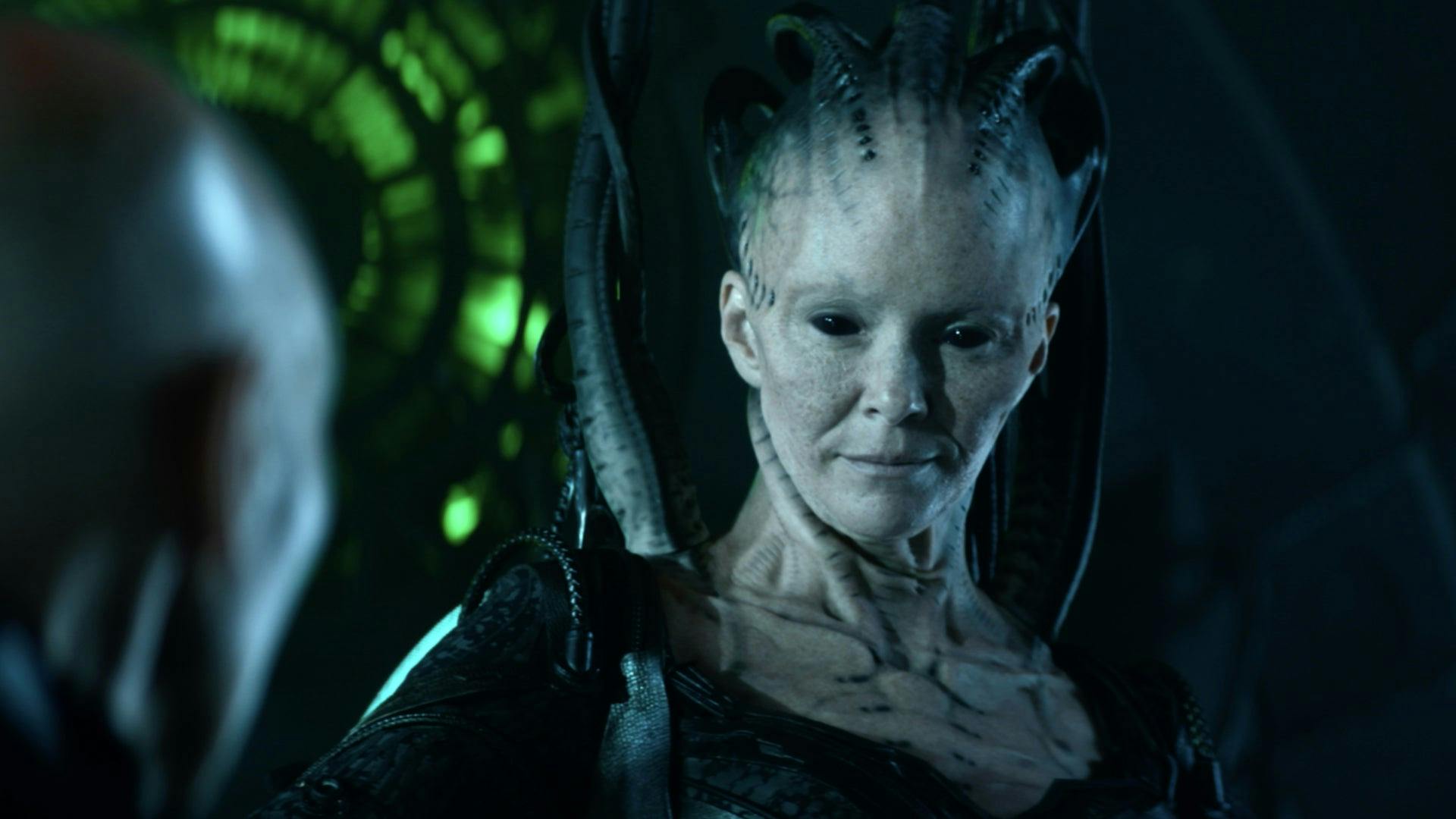
StarTrek.com
“I am the beginning, the end, the one who is many. I am the Borg.”
The central locus of the Borg Collective is the amoral Borg Queen . Through her, like the queen of an insect colony, the Hive mind is granted order and common direction.
As the Villain Showdown enter its fourth week, pitting the Borg Queen against Gul Dukat , we’ve put together this handy guide on everything you need to know about the Queen.
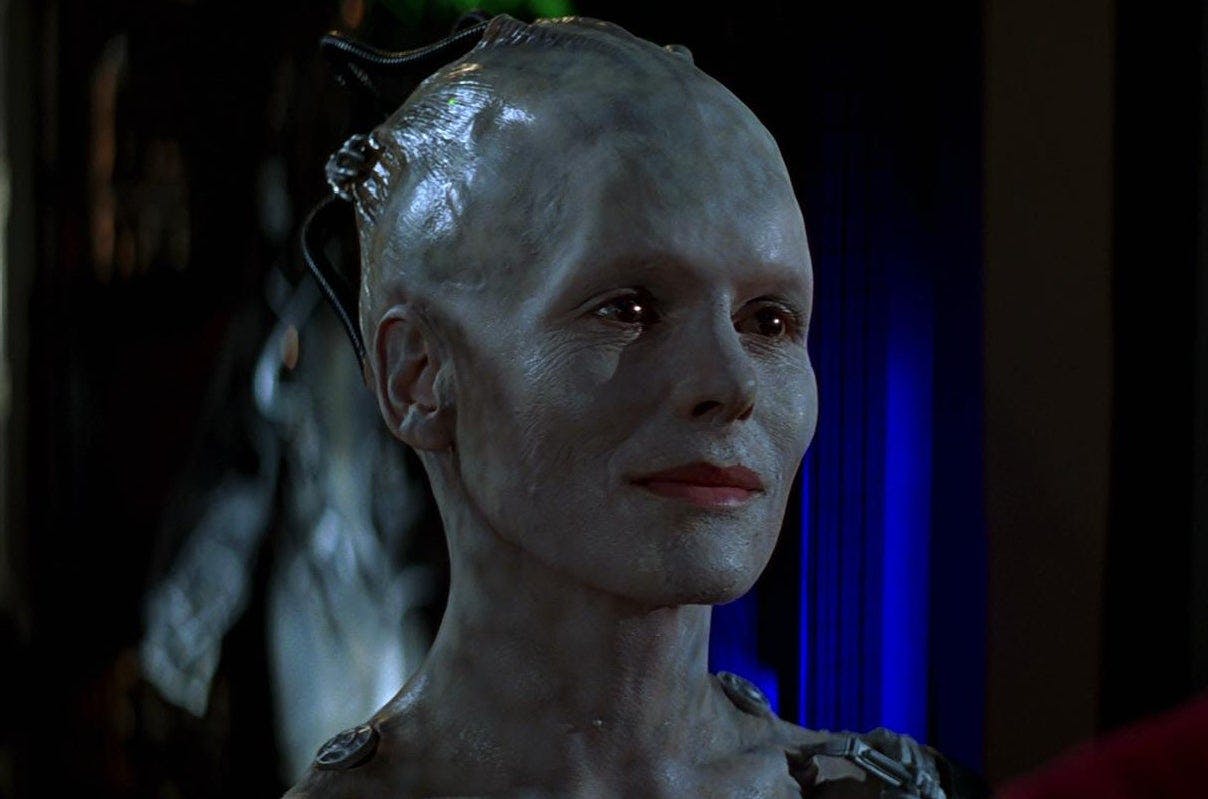
The One Who is Many
Throughout the history of the Borg Collective, there have been a number of Queens. Only one Queen exists at any given time; when she is destroyed, a new Queen takes her place. In Star Trek: Voyager, it's revealed that the Borg Queen isn't a singular entity, but the name given to any that serves as its host, possessing all previous Queen's collective consciousness.
The Borg , a fusion of organic and synthetic matter, and their relentless pursuit of perfection brought fear to all quadrants of the galaxy. Residing primarily at Unimatrix One in the Delta Quadrant , the Borg Queen is the only one able to think independently from the Collective; possessing a unique personality and sense of individuality — traits not seen within the Borg.
The first Borg Queen (Alice Krige) made her debut with Star Trek: First Contact (1996) as the Borg sought to erase a historical moment in Starfleet history— First Contact Day —traveling back in time to prevent the creation and need of the Federation .
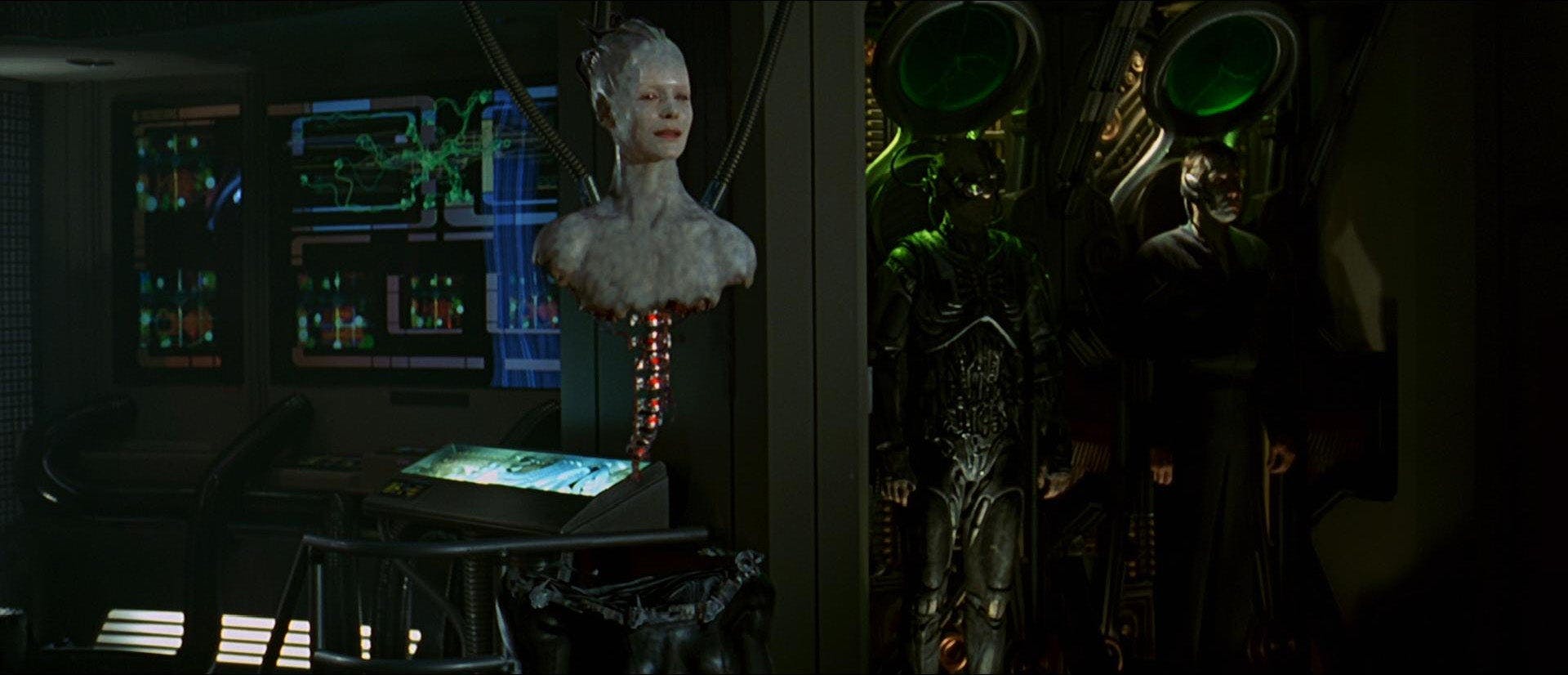
In her lair, the Borg Queen remains disembodied with just her head and spinal column — the epitome of perfection — with no remnants of her humanoid form. When she leaves her home base for assimilation efforts, she will reassemble herself into a predominantly artificial body.
Your Culture Will Adapt to Service Us.
The Borg doesn’t value the Federation’s belief in individuality – its mission is to add others’ biological and technological distinctiveness to their own, strengthening the Collective in its pursuit of perfection. Defeating their opponents isn’t enough; they sought to assimilate their enemies’ minds and flesh.
Captain Jean-Luc Picard still endures residual trauma decades later following his assimilation into the Borg . As Locutus of the Borg, selected to be their voice to facilitate their introduction into human society, Picard believed he never fully regained himself after they striped away his humanity and sense of self.
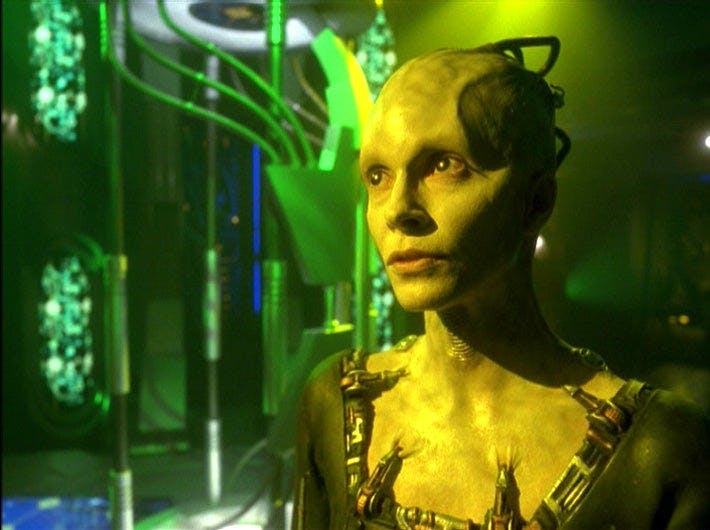
There is No 'Me,' Only 'Us'
It is in Star Trek: Voyager where we learn that the Borg Queen, obsessed with power, didn’t create the Borg; she was just tasked with leading the Collective. The collective consciousness, where each drone is linked through the subspace network, allows for the Borg to adapt quickly and eliminate threats as they arise.
In the episode " Dark Frontier " of Star Trek: Voyager, the Borg Queen believes Seven of Nine 's presence is vital to their path forward in their approach to assimilate Earth, seeing value in Seven's knowledge of humanity. The Borg Queen tries to lure her back to the Collective by "allowing" her to remain an individual instead of reverting to a drone. The Queen's seduction involved telling Seven she's "unique," and her experience will add to their perfection. However, she can't be selfish and only think of just her individual self.
Resistance is Futile.
When a Borg Queen is destroyed, another Queen is propped up. Susanna Thompson portrays the Borg Queen in Star Trek: Voyager ’s two-parter, “ Dark Frontier ” and “ Unimatrix Zero .”
Most recently, the Borg Queen was played by Annie Wersching in Season 2 of Star Trek: Picard .
Secrets of the Borg Queen, The
Bringing Order to Chaos
In Star Trek: Picard , the Borg Queen is cut off from the Borg Collective due the actions of Q and a divergence in time. As a result, she becomes wholly and fully obsessed with Agnes Jurati.
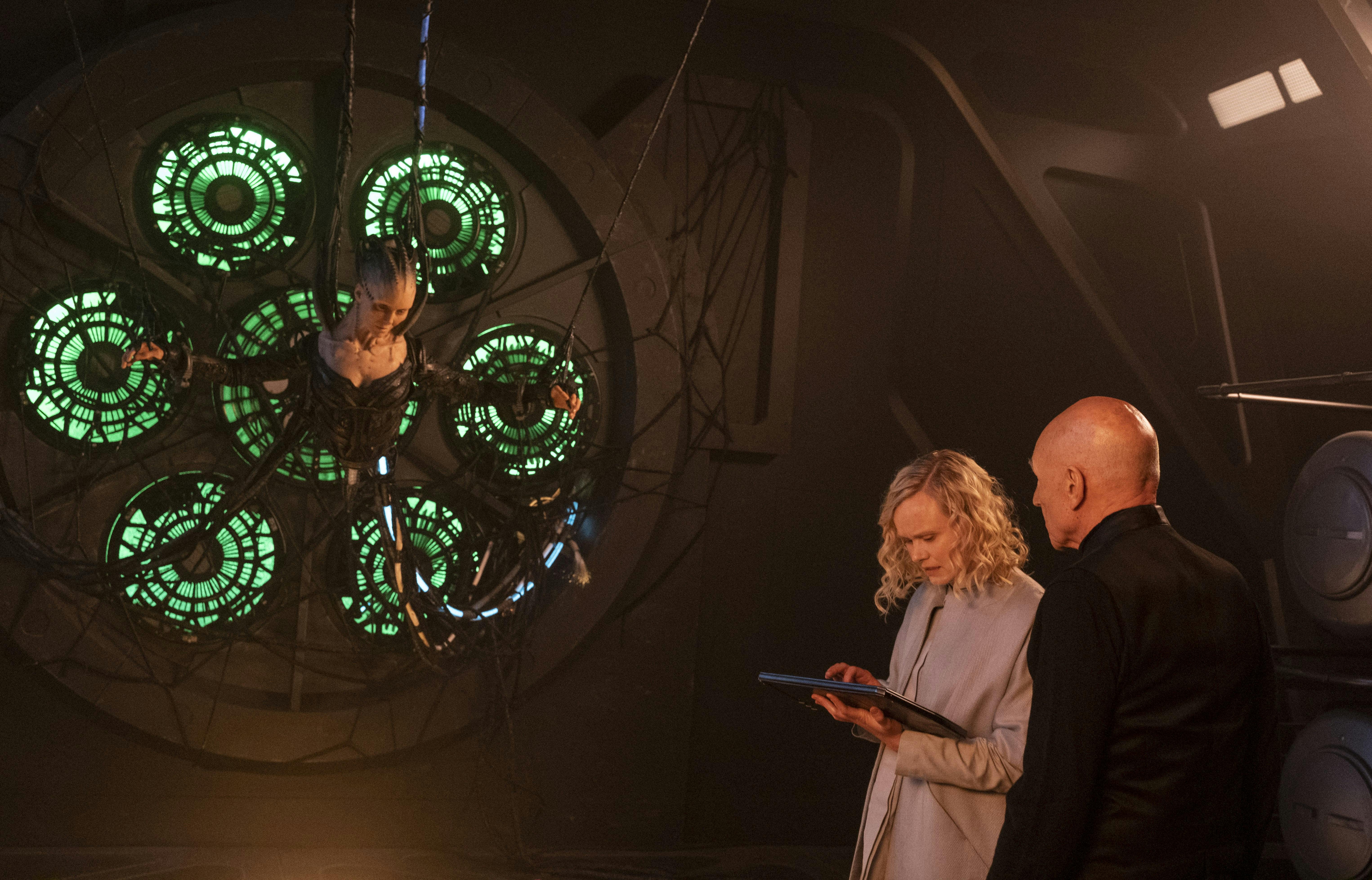
Seen as the last of the Borg, instead of finding the Collective, she sets her sights on Agnes in hopes of building out a new Borg collective.
Star Trek: Picard - The Borg Queen Returns
Interested in learning more about the Borg Queen and her latest machinations, stream all episodes of Season 2 of Star Trek: Picard now!
Christine Dinh (she/her) is the managing editor for StarTrek.com. She’s traded the Multiverse for helming this Federation Starship.
Star Trek: Picard streams exclusively on Paramount+ in the U.S. and is distributed concurrently by Paramount Global Distribution Group on Amazon Prime Video in more than 200 countries and territories. In Canada, it airs on Bell Media’s CTV Sci-Fi Channel and streams on Crave.
Stay tuned to StarTrek.com for more details! And be sure to follow @StarTrek on Facebook , Twitter , and Instagram .
Get Updates By Email
Flickering Myth
Geek Culture | Movies, TV, Comic Books & Video Games
The Line is Drawn Here on Star Trek: First Contact’s 25th Anniversary
November 22, 2021 by Ricky Church
Ricky Church celebrates Star Trek: First Contact on its 25th anniversary…

As Star Trek: The Next Generation came to a close and had its first feature film adventure with Star Trek: Generations , showing a brief team-up between Captain Kirk and Captain Picard, one couldn’t help but wonder what else could be in store for TNG . After all, the series had one of the most perfect finales ever and Generations seemed like a good epilogue as several character journeys came to a close: Picard accepted his found family of the Enterprise, Data finally got an emotions chip and Guinan’s mysterious history was explored a little further. Where else could TNG boldly go?
The answer was to revisit one of, if not the, most defining moments of TNG : Picard’s assimilation into the Borg Collective. 25 years ago today, Star Trek: First Contact was released in theatres and it was the biggest adventure yet for Picard and the Enterprise as they engaged in a climactic battle against the Borg for both the survival of the human race and the future itself. First Contact is one of the best and most powerful films of the Star Trek franchise for pushing Picard, Data and the rest of the crew into very a dangerous and personal place.
First Contact saw the Borg attack Earth head on with just one Borg Cube, once again showing how dangerous an adversary they were against a whole fleet of Starfleet vessels. When the Enterprise reaches Earth just in time to turn the tide, the Cube launches one escape ship which travels back in time. As the Enterprise follows and quickly discovers the Borg are trying to stop First Contact, when humanity developed warp speed capabilities and met extraterrestrial life for the first time, they have to ensure First Contact still happens while Borg infiltrated the Enterprise and assimilate the crew one by one.

Star Trek: First Contact is a different kind of film than most others in the Star Trek franchise. While there are still conversations about humanity’s growth and philosophy, First Contact is one of the more action-oriented entries in the film series. It’s almost like Die Hard in space as the Borg have effectively taken control of the Enterprise and continue to advance deck by deck with the crew fighting a guerrilla campaign against them when they’re not being assimilated. Heck, at one point Picard, Worf and Dr. Crusher even sneak through the ship’s Jefferies tubes to escape the Borg much like John McLane does in the building’s vents. The action genre approach appealed to more than just Star Trek fans as many in the mainstream audience went to see it. Its popularity is on par with Star Trek II: The Wrath of Khan , a film many had named the best in the series up until First Contact where some have said it might be better than Khan . However, the action aspect isn’t the reason why First Contact is a great film.
For Picard, this is a very personal mission on two levels. The first is his dedication to the Federation and its ideals. Picard is a captain who deeply believes in what the Federation and Starfleet stands for, acting as almost an ambassador more than a captain many a time throughout TNG . For the Borg to strike at the very moment humanity changed course in a new age of technological and philosophical advancement was something Picard obviously could not stand by as it would destroy everything he believed in. On the second level, this battle against the Borg was deeply personal as he still hadn’t fully recovered from the trauma of his assimilation. He was stripped of all his individuality and led an attack against Starfleet before the Enterprise was able to save him. His unresolved feelings was in fact the reason why Starfleet did not want Picard involved in the defence of Earth as his anger could cloud his judgement.

Picard initially seemed fine, putting his person feelings aside, but over the course of the film his anger grew until it finally boiled over. His development in First Contact is why it is considered an essential piece of Picard’s history . Many have likened First Contact to The Wrath of Khan with its themes of revenge and sacrifice, but what is interesting is how the story places Picard in the shoes of Khan rather than Kirk. It is Picard who is obsessed with vengeance as his anger and resentment gradually grows from killing an assimilating officer to ordering his men fight a futile battle with their literal bare hands, even going so far as to call Worf a coward.
As much as Picard tells Lily, their human ally from the past, that concepts like revenge don’t exist in the 24 th century, he still goes on a massive tirade where he delivers a memorable monologue ending with him screaming “The line must be drawn here! This far and no further! And I will make them pay for what they’ve done! ” It is no coincidence both Khan and First Contact reference Moby Dick with Lily likening Picard to Captain Ahab and Khan and Picard both quoting passages from the book. Whereas Khan became blinded by his desire for vengeance, Picard was able to see how irrational he was being. Lily brought him back to a sense of sanity as he finally placed the well being of his crew above his selfish needs and made up with Worf.

While it was not the first Star Trek film to do so, First Contact split up the main members of the crew on their own individual journeys and missions. Riker, Troi and Geordi are on Earth, helping a reluctant Zefram Cochrane, the man who invented the warp drive and is less of an idealist than history made him out to be, complete the Phoenix shuttle to ensure First Contact while Data is captured by the Borg with the Borg Queen trying to convince him to join the Collective. Data’s story is just as interesting as Picard’s as the Borg Queen mocks him for being a great machine wanting to be human. He’s even given real skin that makes him feel true sensory inputs like a cool breath and pain all in an attempt to turn him. The friendship between Picard and Data is what ultimately helps them achieve their victory against the Queen and save the future.
The supporting characters are also great, being some of the most memorable in any Star Trek film. James Cromwell is magnificent as Cochrane, being a jaded, cynical and nearly drunken figure who believes more in the wealth and fame warp drive could bring him and becomes overwhelmed at his significance in the future. Alfre Woodward’s Lily is a powerful foil for Picard, a woman with a no-nonsense attitude who is ready to jump into action and tell Picard some hard truths. In many ways Lily is the heart of the film as her outsider perspective helps enlighten Picard as well as how much she comes to believe in the special future awaiting humanity. Though, as Picard tells her at the end in a very poignant moment, it is he who envies her as she will actually witness the events he’s only read and dreamt about.

Star Trek: First Contact is a great entry into the Star Trek franchise. It explores Picard, Data and the other characters and pushes them forward in interesting ways. Its themes on vengeance and coming to terms with the past (and future) are very well written and insightful. It is very much a worthy piece of Star Trek to celebrate on its 25 th anniversary.
SEE ALSO: To Boldly Go: Ranking Every Star Trek Movie From Worst To Best
Ricky Church – Follow me on Twitter for more movie news and nerd talk.
YOU MIGHT ALSO LIKE:

Must-See Modern Horror Movies You Might Have Missed

Yellowstone: Interesting Fan Theories About How The Taylor Sheridan Show Will End


An Exploration of Bro Camp: The Best of Campy Guy Movies

20 Epic Car Chases That Will Drive You Wild

Asian Shock Horror Movies You Have To See

20 Essential Criterion Collection Films

Underrated Movies from the Masters of Action Cinema

The Essential Exorcism Movies of the 21st Century

The Essential Modern Conspiracy Thriller Movies

Takashi Miike: The Modern Godfather of Horror
- Comic Books
- Video Games
- Toys & Collectibles
- Articles and Opinions
- About Flickering Myth
- Write for Flickering Myth
- Advertise on Flickering Myth
- Terms of Use
- Privacy Policy
- Lower Decks
- Short Treks
- Strange New Worlds
- Deep Space Nine
- Star Trek: Picard
- The Next Generation
- The Original Series
BREAKING – Holly Hunter Joins Star Trek: Starfleet Academy Series
Updated: star trek books 2024, star trek’s lost original enterprise model returned, classic star trek alien in star trek: section 31, star trek renewal news – cast & creatives respond, review – sons of star trek #3, review – star trek: discovery finale ‘life, itself’, review – star trek: celebrations, review – star trek: discovery ‘lagrange point’ (s5, ep9), review – star trek: defiant #15.
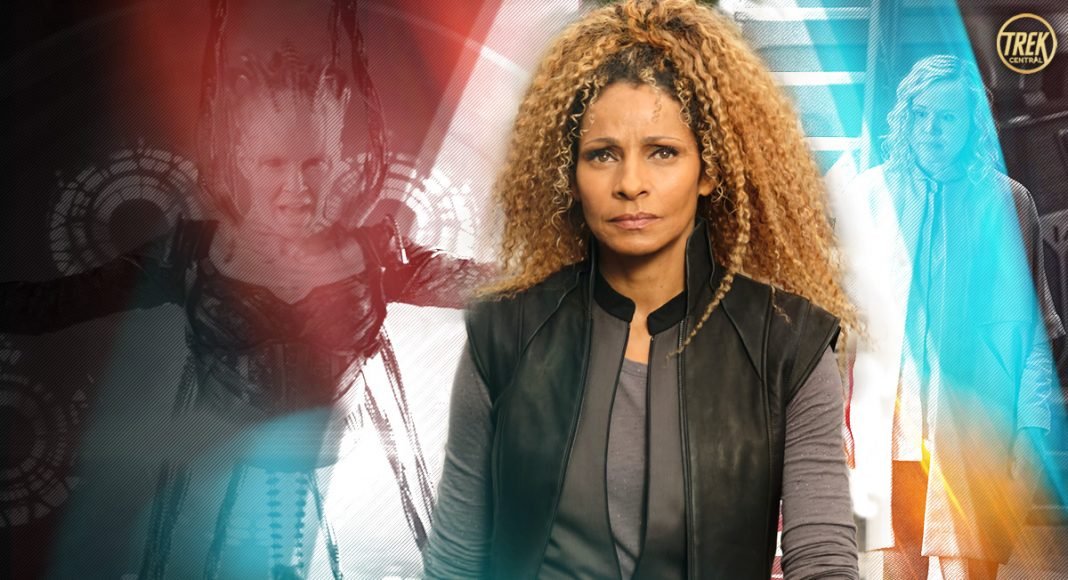
REVIEW: Star Trek: Picard ‘Assimilation’
This week’s new episode of Star Trek: Picard is ‘Assimilation’. Written by Kiley Rossetter & Christopher Monfette, and directed by Lea Thompson (of Back to the Future fame).
SPOILER WARNING – As usual, if you’ve not seen the episode then be aware, there are lots of spoilers ahead!
This season of Picard doesn’t miss a beat, does it? Whereas much of the first season seemed to meander around, the first three episodes of season two contain a focused vision. Every event matters, and thus the cliffhanger between “Penance” and “Assimilation” has a transition of only a few seconds. We pick up exactly where we left off last week, with Picard and the crew of the La Sirena held at phaser point by the Confederate soldiers. Our heroes have no choice but to relinquish their weapons, and despite a last-ditch effort of Oscar-caliber acting by Seven of Nine, they are found to be imposters.
Not all is lost, though. Agnes is the sole crew member not in sight, and she unleashes the Borg Queen to assist in their escape. In a matter of moments, the La Sirena intruders and the Confederation starships are destroyed. La Sirena soon is warping around the sun, and back in 2024. And with that, this season’s story is in full force.
A Matter of Life and Death
The action in “Assimilation” also leads directly to the fate of Elnor. The phaser blast he took turns out to be fatal. A frantic few minutes take place, where La Sirena systems are failing and there is limited power during the escape and warp around the sun. With the ship’s power fading fast, quick decisions are made. And unfortunately, it is a choice of who lives, Elnor or the Borg Queen. Objections are voiced loudly as Picard, the ranking officer, orders that the Borg Queen live.
Picard has been here many times before. He knows the stakes and realizes that the needs of the many outweigh the needs of the few. The Queen must live, as she is the sole source that can help them identify who the Watcher is, and also how to repair the past. Picard has known Elnor since he was a child, but the damning choice is clear: the ship’s limited resources must save the Borg Queen. The future depends on this choice.
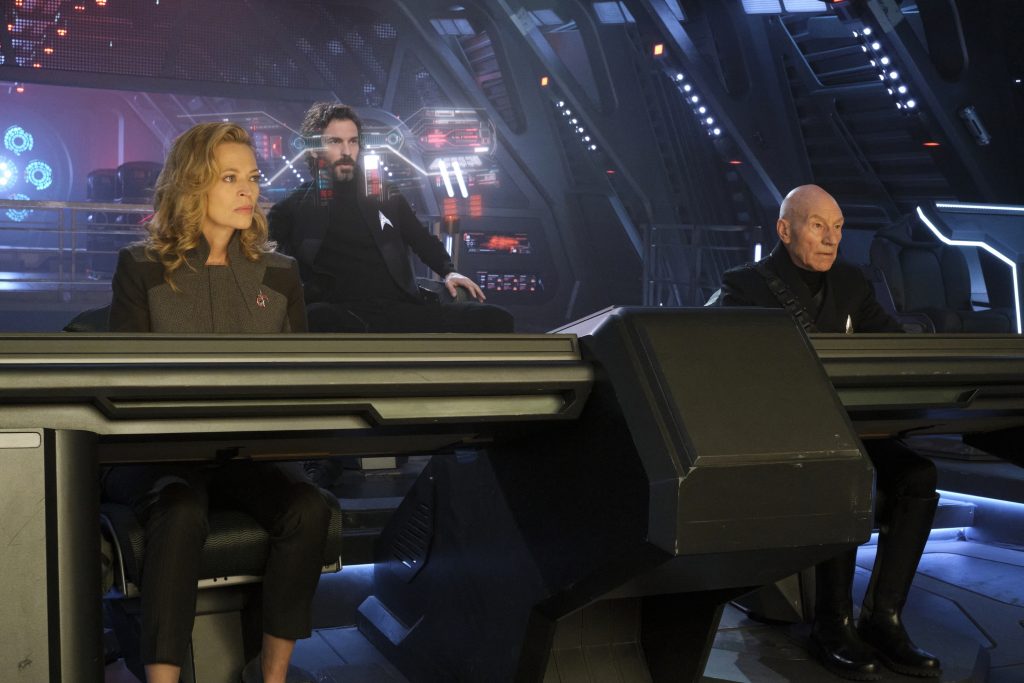
Picard of Old
I couldn’t help but notice that the Captain Picard of old is present in these scenes. He knows what course of action must be taken, regardless of his personal preferences. There’s a mission at hand and far more than one life is at stake. He compartmentalizes his emotions for the mission as he so often has in his storied career. Needless to say that not everyone agrees with Picard. Raffi blames Picard for Elnor’s death. She question’s Picard’s leadership, and insinuates that he is collaborating with Q in a “game” that results in other people’s lives. Knowing her pain, Picard takes most of these accusations without rebuttal, but vocalizes that he and Q do not operate on the same moral compass.
There’s a bit I found unsettling in this scene though. With emotions running high, it appeared that Seven and Raffi (and to a lesser extent, Rios) were too quick to argue that the Queen should die in order to save Elnor. Perhaps I misread the scene, but there seemed to be an eagerness to have the Queen die. The devotion to Elnor is obvious and the fear of the Queen is justified, but there was something about how the attitude towards the Queen’s death that seemed strikingly off about how our heroes approached this situation.
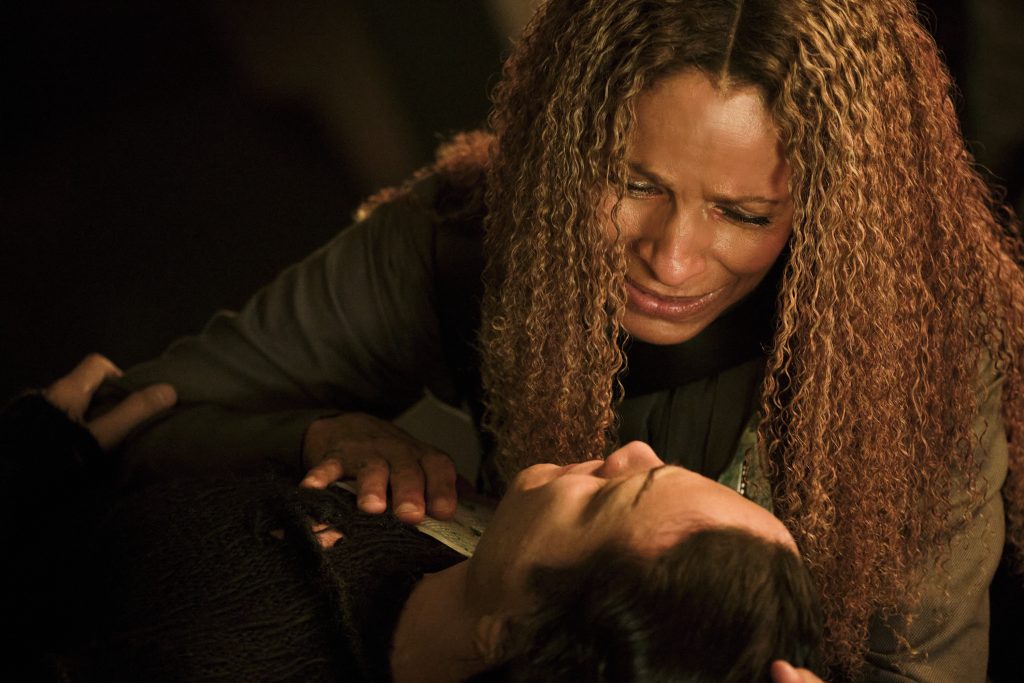
On the positive front, I’m proud of Picard and Raffi. With Picard, I’m grateful that he has found himself again after appearing lost during much of the first season. He’s not oblivious to the pain and loss around him. But just like he was on the Enterprise when someone under his command died, his focus remained stable and his resolve unshaken. He is being the foundation that those around him need. And for Raffi, I’m proud that she focused her hurt on productive means rather than a destructive one. Raffi became a mother figure to Elnor, and his death rattled her. She needed someone to blame, and Q is too abstract to attack in the moment. So she goes after Picard. But only for a moment. Deep down, I think Raffi knows Picard is right, and thus advances the mission to find the Watcher.
The big question here: Can Elnor be saved while repairing the past? Only time will tell, but if I’m a betting man, we haven’t seen the last of Elnor.
Assimilate This
Dr. Jurati is the star of this episode. Knowing options are limited, she offers a plan that Picard objects to from the moment it is suggested: Jurati wants to restart the Queen back to function via an interface with herself, and do so before she’s assimilated. Finally realizing that there are no other viable option, Picard agrees. Stewart, Pill, and Wersching are all at the top of their game, resulting in a captivating set of scenes that advance the story of needing the Borg Queen for this mission, providing much-needed and long-awaited depth for Jurati, and providing us with a slowed down assimilation process that outlines just how the Borg infiltrate the minds of those being assimilated. Jurati and Picard offer a play-by-play of assimilation, and it provided fascinating world-building of the Borg.
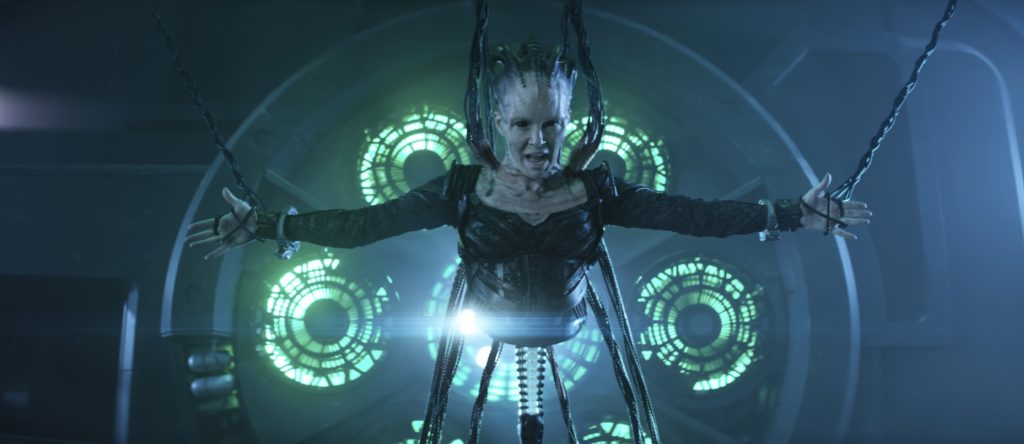
With the Queen back online, she angles Picard for a deal: She’ll trade information on the Watcher in exchange for the ship. But Dr. Jurati was one step ahead during all of this, and managed to steal, at least partially, the needed information. You could see the glee on Jurati’s face when her plan worked and she outsmarted the Queen. It was like her version of Worf’s Borg-killing line in First Contact : a smirky “assimilate this”.
This is the Dr. Jurati I’ve been waiting for. I was drawn to this character when she was introduced in Picard ’s pilot, but soured based on the choices the season one storytellers made for this character in the latter half of the first season. Jurati has returned to form: a brilliant, quirky, and surprisingly brave character that offers great insight to this crew. I hope we get much more of this.
Picard has also reinvigorated the Borg. I thought the Borg story was over and done. Voyager teetered to the point of the Borg being overused, and with that the Borg lost the scary edge that they once had. But Terry Matalas and his team have found uncharted and interesting angles to explore. And once again I find the Borg to a terrifying looming threat.
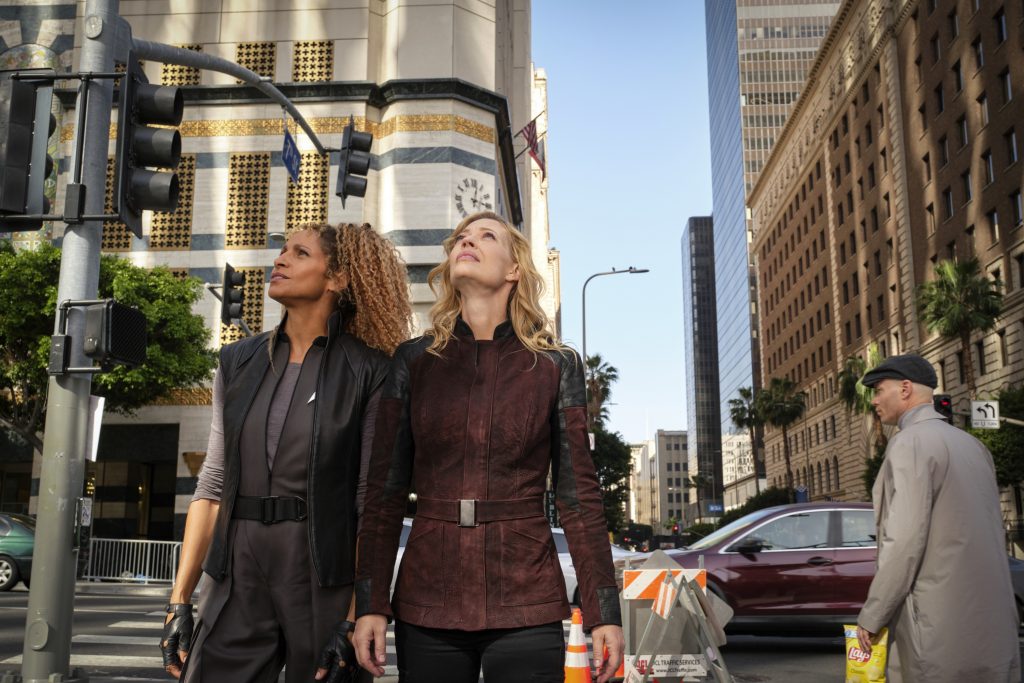
Back to the Not-So-Distant Future
With Picard and Jurati assigned to the La Sirena , Seven, Raffi, and Rio beam down to 2024 Los Angeles in search of the mysterious Watcher. With the ship’s power limited, beaming is inexact. They are separated from one another, and Rios has…a rough landing. The nods to Star Trek IV: The Voyage Home are present in this episode, and likely will be for the next few. In this case, Rios takes Chekov’s role and finds himself in a hospital. Alone and unable to communicate with his shipmates, Rios must navigate concealing his identity, obtain his combadge, and not disrupt the timeline. He comes remarkably close to doing this, but the clinic he is treated at is targeted by immigration police and he and his doctor are apprehended. The Rios sequence worked well, providing humor to balance the heaviness of the La Sirena sequences.
Seven and Raffi make for a great pair. You can see why these two are attracted to each other, but you can likewise understand just why the relationship didn’t work. It’s a joy to watch these two together, and the out-of-time angle allows them to display a humorous side that is not often present. Like in “Penance”, we get to see some of the Seven of old come out. Here, we get her trying to convince a security guard that they are on the roof of a skyscraper to take a selfie, but she is using too technical and someone inaccurate wording to describe the situation. It reminded me of her early days on Voyager when she was trying to figure out how to communicate and be a part of the crew.
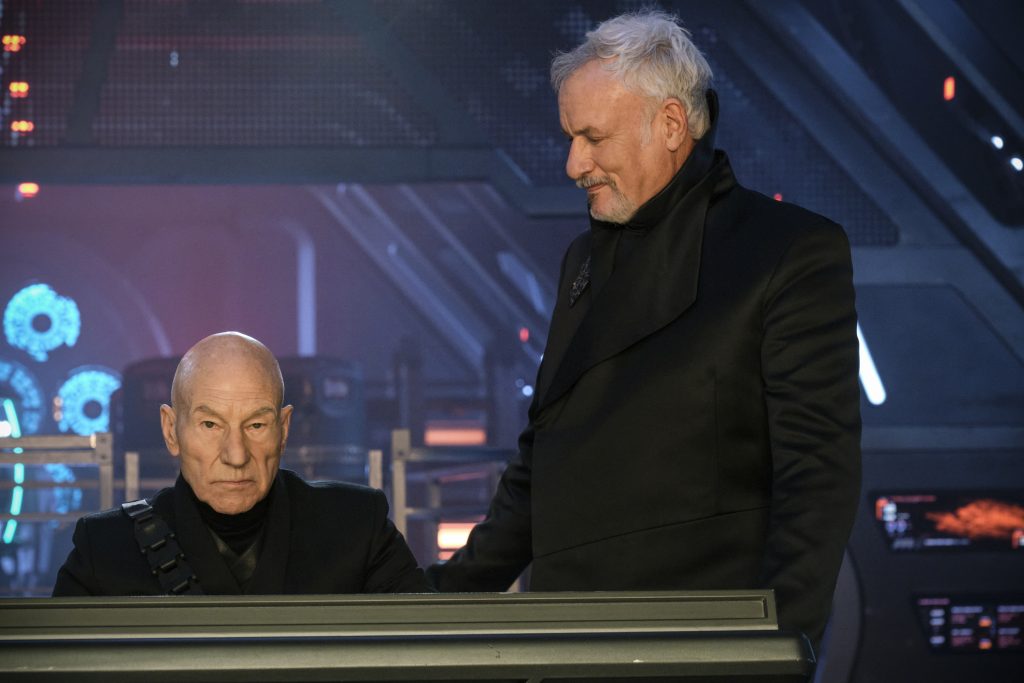
The Ongoing Trial
Q is used sparingly in this episode, but his impact hovers over many of the events. I suspect that will be the case for much of this season. The writing team has struck a good balance: insert Q at precise moments to inform and push Picard, but let him remain in the background most of the time. The character of Q works best as a force of nature rather than a visible presence and leaning into that element of the character is making for a successful season.
Final Thoughts
“Assimilation” concludes the three-episode introduction to this season. While I found the first two episodes to be stronger and more captivating, “Assimilation” still offers a compelling story that has set up a series of interesting challenges for different sets of characters. These first three episodes set an extremely high bar for the remainder of the season. The crew is now firmly in the 21st Century for the foreseeable future. I’m curious to see if the middle of this season lives up to what has been established thus far.
Subspace Monitoring
Not nearly as many nods and easter eggs this week, but here’s a few things I noticed:
- A wonderfully updated version of the crew going back in time as depicted in The Voyage Home
- Like in The Voyage Home , the main crew is not using a Federation starship to go back in time. The Klingon ship in the film and the La Sirena here offer a ruggedness that works well for a story that displaces the crew
- Teresa references Rick & Morty , a show that Lower Decks show runner Mike McMahan has worked on. Does this mean McMahan exists in Trek canon? Is Star Trek in Star Trek ? My brain hurts with this possibility.
- Raffi is beamed down to a homeless encampment that contains signs for “Sanctuary Districts”, seen in the excellent two-part episode of Deep Space Nine “Past Tense”. In that episode, Sisko, Dax, and Bashir are in 2024 San Fransisco, which means it is very likely that Picard and crew are present at the same time as the Deep Space Nine crew.
Episode Skills
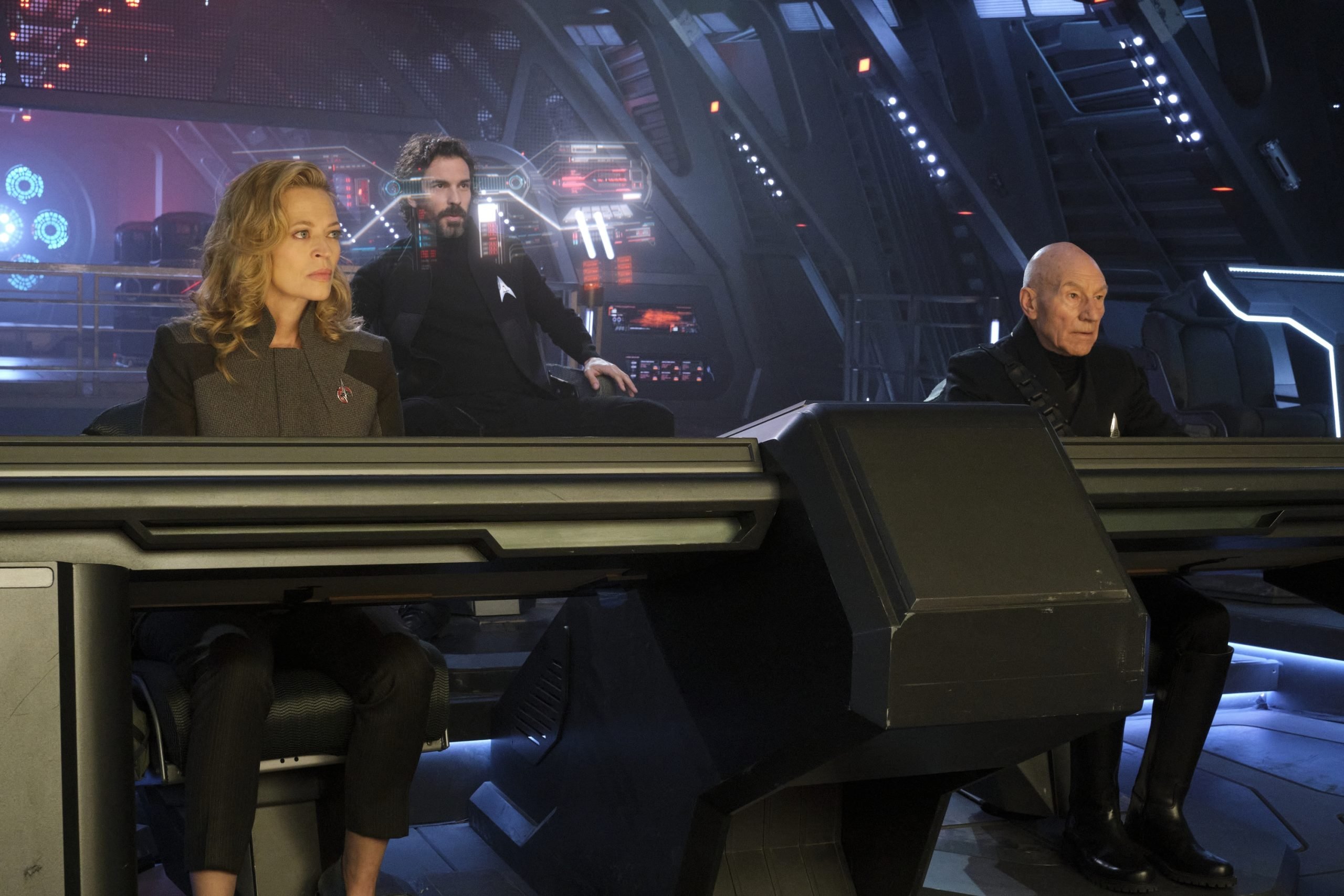
More from Trek Central:
? – REVIEW: Star Trek The Mirror War – La Forge #1
? – Everything We Know About Star Trek: Discovery Season 5
Join the Star Trek conversation via our social media platforms:
- Facebook – https://www.facebook.com/TrekCentral
- Instagram – https://instagram.com/TrekCentral
- Twitter – https://twitter.com/TheTrekCentral
- YouTube – https://youtube.com/TheTrekCentral
- Discord – https://discord.gg/f62Gbcu
- Picard Season 2
- Star Trek Picard
- Star Trek Picard Season 2
more star trek 🖖
the latest 🚀
- Privacy Policy
- Cookie Policy
Trek Central is not endorsed, sponsored, or affiliated with ViacomCBS / CBS Studios Inc or the STAR TREK Franchise. All STAR TREK trademarks, logos and images © CBS Studios Inc.
© 2019–2023 Redwood Media LTD
Picard’s Massive Villain Return Actually Fixes A First Contact Plot Hole
“I can hear them.”
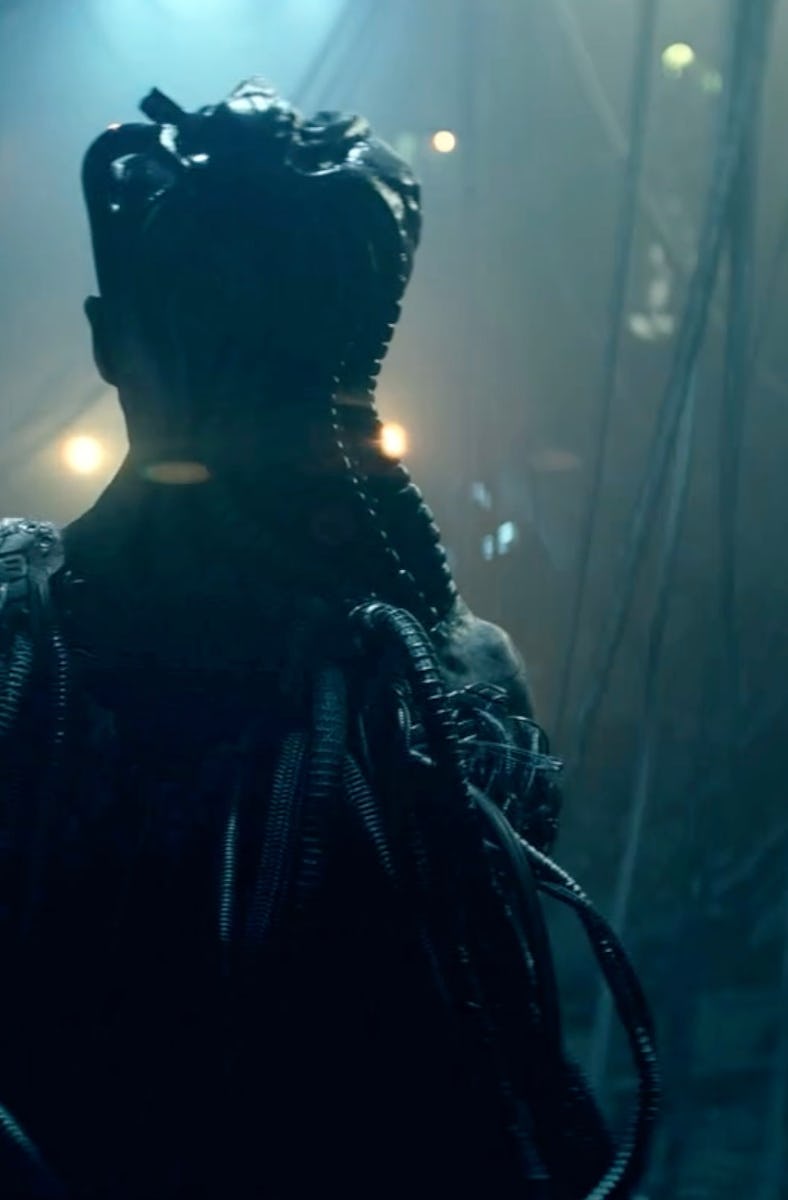
In the penultimate episode of Picard Season 3 , the show’s biggest twist redefines not only the entire season but one of the most epic conflicts in Star Trek canon. Although the primary villain this season has its origins in Deep Space Nine , it turns out that somebody else has been pulling the strings. But the return of this specific villain isn’t just a twist for the sake of it. Instead, a very old mystery from 1996 has finally been solved. Here’s what that huge twist from Picard Season 3, Episode 9 means, plus some clarification from showrunner Terry Matalas about a very specific floating head.
Warning! Spoilers ahead for Picard Season 3, Episode 9, “Vox.”
Early in the episode, the mystery of what’s behind the “red door” in the mind of Jack Crusher reveals the unthinkable: Jack has the Borg in his blood!
Turns out Jean-Luc Picard accidentally passed down what Data calls “dormant biological Borg adaptations.” Although the Prime Universe Borg was (mostly) defeated by Janeway in the Voyager finale “Endgame,” it turns out the original Borg evolved in a new way, which allows assimilation via Jean-Luc’s altered genetic code. The entire Changeling plot was specifically designed to slip Picard’s old Borg code into every Starfleet transporter and give everybody a piece of Borg in their body. Meanwhile, Jack — as Jean-Luc’s son — inherited a huge chunk of this genetic tech; which, has turned him into an unwitting transmitter; exactly what the ailing Borg Queen (Alice Krige) wanted all along.
First Contact set up this Picard twist in 1996
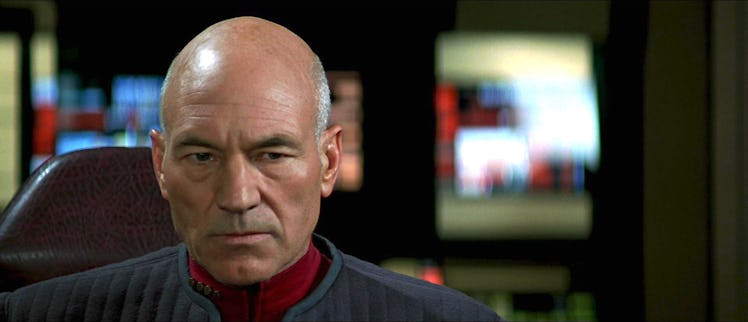
Picard could hear the Borg...way back in First Contact.
Although Jean-Luc Picard was rescued from the Borg Collective in the 1990 TNG episode ‘The Best of Both Worlds Part 2,” we later learned that he retained an ability to “hear” the Collective in the mega-popular 1996 film Star Trek: First Contact . In that film, Picard was able to sense the Borg, and thus, give Starfleet the ability to destroy one specific Borg Cube. But, at that time, we never knew why he had this superpower. Because Jean-Luc never faced the Borg again, it’s taken this long to actually solve this mystery.
In “Vox,” Data and Geordi explain that the genetic alterations that the Borg made to Picard’s DNA turned him into a “receiver,” of Borg communication, while Jack is a “transmitter.” Jean-Luc realizes the significance of this revelation, saying that it “was why I could still hear them after I was assimilated.” Data adds that Picard’s “body” was the thing that could still hear the “voice of the Collective.”
Who controlled the Changelings for the Borg?
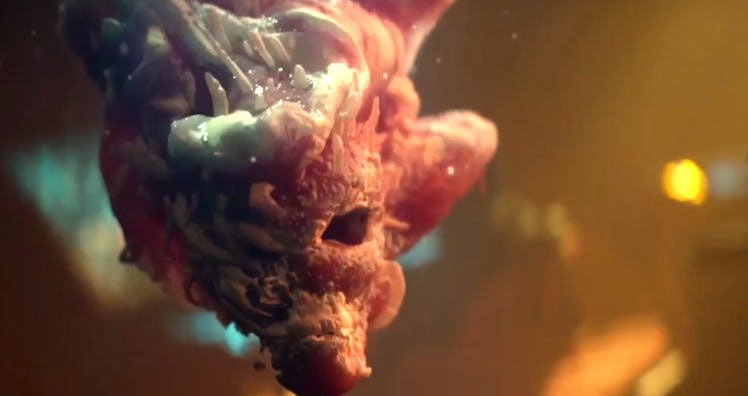
Turns out this is the Borg Queen, too.
Throughout Picard Season 3, Vadic’s handler appeared as a mystery floating face, who some fans have dubbed “meathead.” We later learned this was not a Changeling at all. Although some fans might miss this detail, that floating face was, in fact, the Borg Queen all along. When directly asked the identity of the floating face that bossed around Vadic, Picard showrunner Terry Matalas told Inverse “ That’s the Borg Queen.”
“ That’s the Borg Queen.”
Although “Vox” drops a lot of info that seems to change everything about Picard Season 3, all the clues have been there. The Changelings have been messing with the transporter since Episode 4 and Commander Ro told Picard she didn’t trust the transporters back in Episode 5 . In Episode 7, we learned that Vadic busted out of Daystrom Station on her own, and it was at that point she discovered the dormant Borg Code within Picard. In this episode, we learned that the Changelings wanted to weaponize the dormant Borg Code, and the Borg Queen was happy about the team-up.
As Beverly Cruhser says, “Cleary the Changelings have been working with the Borg since the beginning.”
Later, the Borg Queen clarifies this alliance slightly, saying to Jack that the Borg-Changeling team-up was “the vindication of both our species to take everything back from those who live like shattered glass.” Like the Borg, the Changelings have a kind of shared hive minds in their Great Link. Also like the Borg, they have a huge beef with the Federation. Both groups also view individualized humanoid consciousnesses as basically ridiculous.
This episode also makes it clear that the Borg Queen could not have stuck all this Borg genetic code into Starfleet’s systems without the help of the Changelings. This suggests the Borg Queen might be in worse shape than we know. In “Vox,” we don’t even see her face, and her ship seems badly damaged. Clearly, the Borg Queen was desperate enough to enlist the help of the Changelings.
But, that doesn’t mean all of our questions have been answered. Going into the massive Picard Season 3 finale, the vengeance of the Borg feels nearly complete. Unless, of course, one last starship can save the day.
Star Trek: Picard Season 3 streams on Paramount+ .
This article was originally published on April 13, 2023
- Science Fiction
Star Trek: First Contact
Quick navigation:.
Screen Rant
Star trek: first contact ending & picard impact explained.

Your changes have been saved
Email Is sent
Please verify your email address.
You’ve reached your account maximum for followed topics.
Star Trek Confirms the True Power of the Mirror Universe’s Most Devious Weapon
When is the next star trek movie coming out, star trek reveals origin of a vital federation first contact device.
Star Trek: First Contact is not only one of the most popular and beloved big screen entries in the franchise, its overarching plot also features prominently in Star Trek: Picard season 3. First Contact is the second Star Trek film to feature the cast of Star Trek: The Next Generation , and the first one to feature no members of the Star Trek: The Original Series cast. The previous film, Star Trek Generations , united two franchise legends in Captain James T. Kirk (William Shatner) and Captain Jean-Luc Picard (Patrick Stewart), but the film itself was met with a decidedly mixed response.
In all the ways Star Trek Generations stumbled, Star Trek: First Contact excelled. A lean, mean action-heavy affair directed by Jonathan Frakes, First Contact sees Captain Picard and the USS Enterprise-E travel back in time to post- World War III mid-21st century Earth to prevent the Borg from fundamentally altering human history. While Commander William T. Riker (Jonathan Frakes) assists the legendary scientist Zefram Cochrane (James Cromwell) prepare for humanity's first warp flight on Earth, Captain Picard fights a pitched battle against the Borg on the Enterprise-E, joined by a 21st-century native named Lily Sloane (Alfre Woodard). The crowd-pleasing story would have long-lasting effects for Picard and the overall franchise.
Star Trek: First Contact's Picard, Data & Borg Queen Ending Explained
While fighting off the Borg in the first half of Star Trek: First Contact , Lieutenant Commander Data (Brent Spiner) is captured by the cybernetic zombies and presented to their newly revealed leader, the Borg Queen (Alice Krige). The Borg Queen's primary objective is to break into Data's neural net to retrieve codes that would give her full control of the USS Enterprise-E, but she's also intrigued by Data and offers him a chance to join her and explore the possibilities of a partially organic existence with the Borg.
As Star Trek: First Contact progresses, Picard becomes increasingly violent and unhinged. Still haunted by his assimilation in the Star Trek: The Next Generation episode " The Best Of Both Worlds ," Picard begins to lose perspective, perceiving the Borg's destruction as a personal vendetta. After a heated exchange with Lily, Picard ultimately decides to abandon the USS Enterprise-E and activate the auto-destruct sequence to preserve the timeline and wipe out the Borg threat. While the Enterprise-E is being evacuated, Picard ventures to the ship's engineering section, where the Borg Queen is holding Data.
To Picard's shock, Data has now seemingly seen the error of his ways and joined up with the Borg, who have grafted hunks of horrific-looking flesh onto the android's body. However, just before the Borg are able to destroy Cochrane's warp ship, Data reveals it was all a ruse, bursting the warp core's plasma coolant tank and killing all the Borg, including the Borg Queen. With the Borg threat neutralized, Picard and his crew prepare to return home after one final glimpse of history on Earth.
First Contact's Warp Flight & Vulcan Ending Explained
The Borg's ultimate plan in Star Trek: First Contact was to travel back in time and attack humanity at a vulnerable, historically significant moment. Earth was essentially decimated by the time of 2063, still reeling from the fallout of the calamitous World War III. Despite this, Dr. Zephram Cochrane was on the verge of two huge achievements in human history - conducting the first human warp speed flight aboard his makeshift starship, the Phoenix, and making First Contact with alien life.
After successfully completing his warp flight, Cochrane was ready to meet his first extraterrestrials, a moment Picard couldn't help but peek in on. Those pivotal aliens would turn out to be the Vulcans, arguably the most benevolent, altruistic species one could possibly make First Contact with. The gruff, socially loose Cochrane greets the Vulcans with a warm handshake, cheap whiskey, and a Roy Orbison tune, perfectly setting the tone for the long, complicated relationship between humans and Vulcans that Star Trek has always chronicled.
Why Star Trek: First Contact Made A Major Borg Change
Star Trek: First Contact was a success by almost every metric, but it's not without its controversies, the biggest being the introduction of the Borg Queen . The Borg were previously said to have no individuals or leaders, as they were one united hive mind. Producers were adamant that the Borg, easily the most popular adversaries from Star Trek: The Next Generation , feature in the next film installment, but writers Ronald D. Moore and Brannon Braga initially had difficulty figuring out a way to make a big screen villain compelling with essentially no face or voice.
Moore and Braga eventually came up with the idea of a Borg Queen, in the same sort of way insect hives have queens. There's no denying Alice Krige's performance is fantastically creepy and one of the best things about Star Trek: First Contact , and yet her very existence dilutes one of the foundational ideas of the Borg. This wasn't a huge issue with First Contact itself, but further appearances by the Borg Queen - often played by a different actress - in Star Trek: Voyager arguably robbed the character and the Borg overall of their menace.
Star Trek: Picard Season 3 Was A First Contact Sequel
The plot of Star Trek: Picard season 3 was initially framed as a follow-up to Star Trek: Deep Space Nine 's Dominion War, focusing on a splinter cell of Changelings led by Captain Vadic (Amanda Plummer) who sought vengeance against the Federation for the atrocities they committed during the war. That turned to be a bit of a red herring, as Vadic and her Changeling followers were eventually revealed to be working for the Borg Queen, who remained seriously incapacitated along with the rest of the mainline Borg Collective after her encounter with a future version of Admiral Kathryn Janeway (Kate Mulgrew) in the Star Trek: Voyager finale "Endgame."
It's ultimately revealed that the reason Vadic was hunting Picard's son, Jack Crusher (Ed Speleers), was due to Picard's time as the Borg's 'spokesman', Locutus. While under their control, the Borg covertly altered Picard's DNA so that any offspring he produced would house the genetic material to create a new, biological evolution of the Borg. That physical alteration led to the death of Picard's organic body in Star Trek: Picard season 1, as well as the nightmares and strange abilities Jack dealt with for most of his life.
Picard Season 3 Is The End Of First Contact’s Original Borg Queen
In the riveting Star Trek: Picard series finale "The Last Generation," Jean-Luc Picard goes on one last mission as the Captain of the USS Enterprise-D - lovingly restored by Commodore Geordi La Forge (LeVar Burton) - to save Jack and stop the Borg virus that ravaged Starfleet on Frontier Day. Picard is ultimately able to free Jack from the Borg Queen's influence, and the crew of the Enterprise-D managed to destroy the Borg Queen's vessel, seemingly killing her for good this time and reversing the effects of the virus.
This is definitely not the end of the Borg. The benevolent, alternate timeline Borg, led by the assimilated Dr. Agnes Jurati (Alison Pill), are still out there, awaiting a galactic threat and standing ready to assist Starfleet when it happens. But Picard season 3 may be the final chapter for the vicious, almost cartoonishly evil version of the Borg introduced in Star Trek: The Next Generation that really took hold with Star Trek: First Contact . That version of the Borg served their purpose, but it's time for them to play a new role in the Star Trek universe.
- Star Trek: Picard (2020)
Star Trek: First Contact
Star Trek: First Contact is the eighth full-length motion picture in the Star Trek franchise and second movie set in the TNG time-frame.
The film begins with a Borg attack on the Federation . Jean-Luc Picard and the crew of the new Sovereign-class starship Enterprise-E , having the most experience with the Borg of anyone in Starfleet, are naturally sent off to patrol the Romulan Neutral Zone during the attack because of the fear that Picard's former assimilation might make him more of a liability in the battle than an asset. Some time during the battle, Picard and crew decide to dismiss their orders and join the battle. They arrive in time to rescue Worf and the crew of the Defiant . Picard still has some remaining Borg technology in him, allowing him to "hear" the Collective. Through this contact, he learns the exact spot needed to shoot at on the cube to destroy it. The cube is destroyed but launches a sphere before it explodes.
The Borg sphere travels back in time to the twenty-first century. Its goal is to prevent humanity's first contact with Vulcans , thus creating a new timeline where Earth is not strong enough to resist the Borg (contrary to Borg propaganda that "resistance is futile"). Firing from orbit, the sphere damages the first warp-capable ship, the Phoenix , built from an ICBM by Zephram Cochrane . Upon seeing the changes to the timeline, including a Borg-inhabited Earth, Picard orders the Enterprise-E to follow the sphere back in time to attempt to repair the timeline.
The Enterprise destroys the sphere but several Borg, including the Borg Queen transport to the Enterprise and begin assimilating the ship and crew. The surviving Borg make multiple other attempts to change history, each being subsequently thwarted. The final showdown takes place in the Borg hive in main engineering. Data, previously captured and tempted to join the Collective, fires on the Phoenix at the command of the queen. At the last second though, we see the torpedoes miss their target and we realize Data has resisted the queen's temptations. Data kills the queen by smashing a plasma coolant container which dissolves the queen's organic components, killing her, and the queen's death in turn destroys every Borg drone on the ship.
Eventually, the warp flight is made, the Vulcans come to Earth, and the Enterprise returns to its own time.
Continuity problems
Much has been made concerning the history of the man Zefram Cochrane . He and his personality seem portrayed very different in this film than in the TOS episode "Metamorphosis", in which the character first appeared.
The Borg also appear to have been completely changed from their first conceptions. When first introduced, we are told they have no gender, are not interested in humans, just the Enterprise as something to be used. We are also initially given the distinct impression that they have no centralized leadership. We neither saw nor heard of assimilating other life forms with the injectors seen in this film. Data even comments on the contradiction of having a Queen in this film. In the film's defense however, most people's major bugbear with the post-TNG Borg (that they were literally incapable of deductive reasoning and could only understand by assimilating) actually originated with Star Trek: Voyager rather than First Contact .
- ST Canon material
Navigation menu

- June 14, 2024 | Podcast: All Access Shares Its Pain With Laurence Luckinbill From ‘Star Trek V: The Final Frontier’
- June 13, 2024 | ‘Star Trek: Section 31’ Actor Teases His “Very Intense” Character, Praises “Hero” Michelle Yeoh
- June 13, 2024 | Everything Must Go In Final Master Replicas Sale Of Eaglemoss Star Trek Ship Models
- June 12, 2024 | Alex Kurtzman Talks Avoiding Star Trek Fan Service And Explaining Floating Nacelles In ‘Starfleet Academy’
- June 12, 2024 | Anson Mount Says ‘Star Trek: Strange New Worlds’ Season 3 Takes “Bigger Swings” Than Musical Episode
5 Things We Learned About ‘Star Trek: First Contact’ On Its 25th Anniversary Year
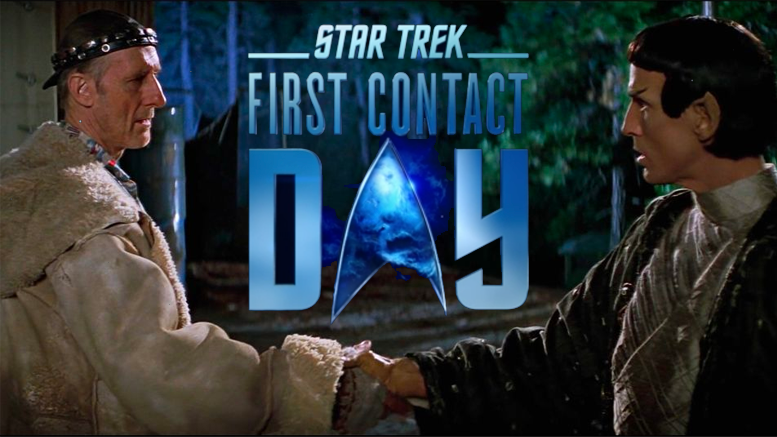
| April 6, 2021 | By: Kayla Iacovino 20 comments so far
Yesterday’s virtual First Contact Day event put on by CBS has come after over a year of virtual “conventions” that haven’t been able to hold a candle to their normally in-person counterparts. But, with a year of learning and planning, CBS showed that this virtual event thing can actually work. During the “Remembering First Contact” panel, host Wil Wheaton asked insightful questions of Star Trek vets Jonathan Frakes, Patrick Stewart, Brent Spiner, and Alice Krige, getting them to spill a few stories I for one had never heard before about Star Trek: First Contact, which is celebrating its 25th anniversary this year.
Here are a few of my favorite takeaway tidbits that were new to me. For those of you walking Star Trek history encyclopedias, please feel free to expound on these stories in the comments!
Renaissance-era setting nixed for budgetary reasons… and the absurdity
During the “Revisiting First Contact” panel celebrating 25 years since the release of the beloved TNG film, Jonathan Frakes spoke about the genesis of the story of First Contact , saying:
“All three of the writers wanted a time travel story. So, the objective was to find a way to marry those big concepts [Borg and time travel]. Originally it was going to take place in Renaissance Italy, perhaps, and we were going to fight the Borg with swords? Thankfully that idea was taken away for financial reasons and logical reasons and absurd reasons, I’m sure. And, we were blessed with this, arguably the best of the Star Trek movie scripts certainly.”
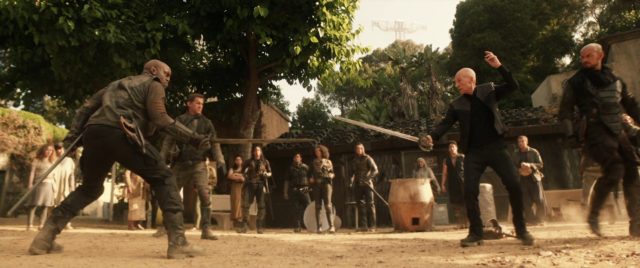
We had to wait until Star Trek: Picard to get those sword fights.
Patrick Stewart had to OK Frakes as director, over Reuben sandwiches
After Jonathan Frakes was asked how he got the job as director, he told the story of the most memorable Reuben sandwich in his life.
“I believe, if the urban myth is true, the movie was offered to Ridley Scott, John McTiernan [who weren’t interested]. As I understand it Sherry Lansing, who was the head of Paramount at the time, told Rick Berman, who was the keeper of the reigns: ‘Why don’t you hire who you like?’ So, there was one caveat. The director that they hired had to be approved by now Sir Patrick Stewart. So, Rick said, ‘I’d really like you to do the movie, but Patrick’s going to have to approve you.’ So, Patrick and I had lunch at Jerry’s Deli in Studio City. And, he said, ‘I’m okay with you directing the movie. I was told that I had to make it official with you. And, that… it kind of changed my life. I believe we both had Reuben sandwiches.”
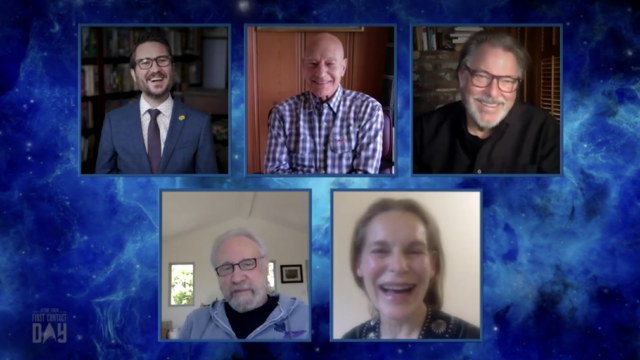
The group shares a laugh over Jonathan’s memory of his favorite reuben sandwich.
Alice Krige asked for a second audition because she thought she blew it (she didn’t)
Before her audition for the role of the Borg Queen, Alice Krige had no real knowledge of what Star Trek was all about. It took doing the audition for her to find the character, and in doing so, she was convinced she had totally biffed the audition. Of course, she hadn’t.
“My agent called me one day, and she said, ‘here are some sides for the next Star Trek movie.’ Now, I have a confession to make that I had never seen an episode of Star Trek. I said okay, but where’s the script? I can’t go in without a script. She said, ‘No, you don’t understand. NO ONE sees a script.’ I had a friend who wrote for Star Trek. I ran over to his house, and I watched all of the Borg episodes that he had on tape. I learned my lines, and I went into Paramount. And, there was Jonathan, and I did the three scenes. And, as I was doing them, I actually started to understand [the role] – it was the act of doing it – it was not intellectual. It was like a channel opened up. They thanked me politely, and I left. I ran to my car, and I drove to find the first pay phone I could find. I called my agent, and I said ‘I screwed it up. Please tell them that I can do better. And, I really want to do it again.’ Well, we didn’t hear from them for three weeks, and I thought ‘another one bites the dust’. And, then I got another call! I went in, and I did the same thing again, and I was offered the Borg Queen.”
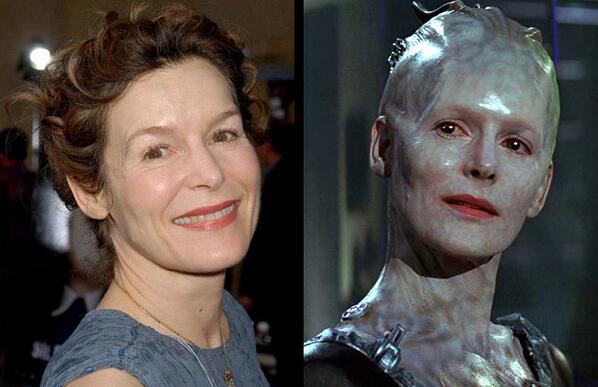
Alice Krige as the Borg Queen.
Alice Krige needed 8 Borg wranglers to work in the Borg Queen costume
Alice Krige – who absolutely slayed in her role as the Borg Queen – spoke about how she got the role and what it was like playing the iconic character. One amusing tidbit was her mention of around eight “Borg wranglers” that were needed during her scenes.
“All the Borg wranglers. Because I must have had eight maybe? Someone who looked after my battery packs, someone who had a big pot of glue and glued the cracks. Someone looked after my feet, my hands, my head. Someone had a huge tube of – what was it? – KY jelly and a sponge. Every one of them helped make [the Borg Queen]. This was the apotheosis of collaboration for me, this role.”
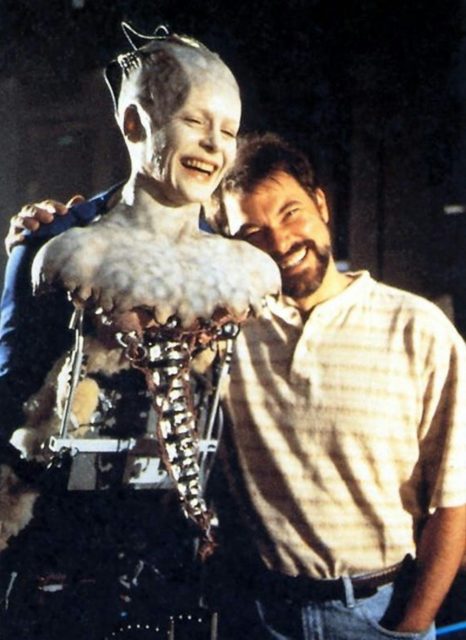
Krige on the Borg Queen rig with director Jonathan Frakes during the filming of Star Trek: First Contact.
Brent Spiner was terrified of doing the missile silo jump stunt
While Brent Spiner had high praise for the film’s director, script, and co-stars, there was one aspect of making the film that wasn’t to his liking.
“We were standing alongside the missile on a platform that was very high in the air. Patrick [Stewart] knows that I am terrified of heights, so he would be bouncing on the platform to terrify me – which it did. [In the film] Data jumps off the platform and sail to the ground, and nothing happens to him. Initially, it was my stunt double, Brian Williams. He did that jump, and Jonathan [Frakes] shot him coming down from the missile silo, and then Jonathan cut to me. They printed all of that, then Jonathan came to me and said, you can tell that it’s not you. You’re going to have to do it. They took me to a soundstage, put me in a harness. And I was terrified. I hated it. They brought me up 3 feet and dropped me, and I hated it, then they took me all the way to the top, and they were to drop me, and a few feet before I hit the ground, a hydraulic slowed me down. I had to be Data, and I was able to do it, and look confident, and I landed, and the crew applauded, and I was so glad it was over. And then ‘Two-Takes Frakes’ came to me and said, ‘can we do that again?'”
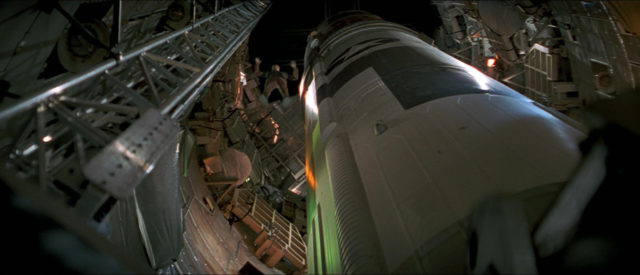
That first step is a doozy.
Watch the full 25th-anniversary panel
Paramount+ has uploaded the entire Star Trek: First Contact anniversary panel to Youtube.
Find more articles on Star Trek history at TrekMovie.com .
Related Articles
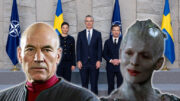
Feature Films (TMP-NEM) , Great Links , Music , Viral Video/Mashup/Images
NATO Explains Why The Theme For ‘Star Trek: First Contact’ Was Played At Sweden’s Induction Ceremony
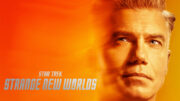
Strange New Worlds
New Character Posters Revealed For ‘Star Trek: Strange New Worlds’ Season 2
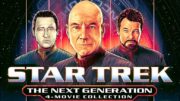
DVD/Blu-ray/Streaming , Feature Films (TMP-NEM) , TNG
Review: ‘Star Trek: The Next Generation 4-Movie Collection’ 4K Ultra HD Blu-ray Is An Engaging Upgrade
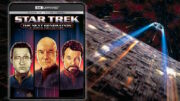
DVD/Blu-ray/Streaming , Feature Films (TMP-NEM)
‘Star Trek: The Next Generation’ Movie Collection On 4K Blu-ray Coming In April
Alice Krige wax the only logical choice to play the Borg queen. While Susanna Thompson was good on Voyager, Alice nailed it and I’m glad she also came back to the roll.
the 1st time Star Trek was a ‘cool’ movie to go see at the cinema
What about The Voyage Home?
yes but that was more of a comedy like Crocodile Dundee/BTTF in space, not so much an Aliens/Terminator type ‘cool’ pg13 scifi action movie that kids teens non fans could rave about in the playground, water cooler, pub etc
The first Trek movie I got to see in the theater…I was 4. I still remember gagging in my seat when Data made out with the BQ. Also I love this cast so much, I wish I was around to get pranked.
This panel was great! And yes even after 25 years and endless conventions it’s always nice to hear new stories and anecdotes which this had a lot of. Spiner’s story about being afraid of heights and doing the jumping scene in the movie was hilarious!
FC definitely had an amazing script and felt the most cinematic out of all the movies not counting TMP or the Kelvin movies. The premise worked so well and a great way to tie into the 30th anniversary sort of how well TUC and its premise tied into the 25th.
While I liked Beyond that was one of its biggest missed opportunities and not having a bigger hook that tied into the 50th anniversary more. It’s a story that could be told in any episode. But I digress.
Anyway great panel!
50th anniversary movie was there for the taking (Orci/Shatner/battle for the timelines) and could’ve been as pleasing as VI and FC, but,like a poor marksman, they missed the target..
I was on set standing in Picard’s Ready Room doorway they filmed all the takes of the “interplexing beacon” dialog scene where Alfre Woodard and Picard come up through the floor. I was so stunned that I was on set watch the new film being made. I remember touching the embroidered delta shield insignia on the back of the seats on the bridge. Jonathan Frakes made the cast do one more take of a shot and said “ok, once more with grace and alacrity” and Patrick Stewart started into a whole Shakespeare joke about the epic love story of Grace and Alacrity, acting it out while the cast and crew laughed as the lights were moved. It was all very funny and surreal. I also got to sit in the Phoenix cockpit and walk (only on the very edge) of the deflector dish. I can’t believe that was 25 years ago. Yikes. I’m old. Oh and I also interviewed Alice Krige in her house in Malibu about playing the Borg Queen. She fed me salt and vinegar potato chips and her little black dog kept licking the crumbs off my fingers. 25 years?? Where does time go???!!!!
That’s a lovely story!
Yes that is a great story. But I thought the interplexing beacon scene was on the bridge? But I love that whole bit. It had some great lines:
“The reports of my assimilation have been greatly exaggerated” “I am a Klingon” “I think’s it time we take a little stroll”
And the gag with Worf scared of zero-G. Love it. Why can’t all Star Trek films be more like this?
Wow. 25 years. I saw this movie in the theaters when I was in college. Dang I feel old now. But I just watched it again yesterday for FC Day and it still holds up very well. I love this movie.
I did hear the Renaissance story before. But it was actually someone wanted to do the time travel to the Renaissance story and someone else wanted to do the Borg. I’m glad they dropped the Renaissance bit and went with the Zephram Cochrane and First Contact story instead.
My regret is that Tom Hanks was initially cast as Zephram Cochrane, which I think would have made for a better and more popular movie. He couldn’t do it since he was directing another movie, but he did want to since he was a big Star Trek fan. James Cromwell was ok, but Hanks would have brought a big name to Trek.
Didn’t Tony Pascale do a DVD commentary for it with Damon Lindelof?
I don’t agree. Hanks was too famous. Too big. I would have watched all the Cochrane scenes and just thought “that’s Tom Hanks talking to Will, Deanna, and Geordi”. Same with the abandoned Eddie Murphy role in Star Trek IV. I’m glad they didn’t happen.
Now, if they want Hanks to cameo as Captain April on SNW, I can be down with that.
But the fact he was so famous could’ve been an added bonus for the character as Cohrene was this huge mythical figure that the TNG guys were in awe of
Tom Hanks is a fantastic actor and I think his performance would have quickly allowed the audience to believe he was Zethran Cochrane in the movie.
Big name actors appear all the time in Star Wars, just check the names.
Cromwell was great as Cochrane (and even more prestigious when you take into account he was in the classic LA Confidential the following year) but yeah Hanks in FC would’ve been a huge deal for a Trek movie in the mid 90s when Hanks was pretty much the biggest movie star on the planet at that time (along with Mel Gibson & Tom Cruise), and maybe brought in another 50 even 100m in box office worldwide
I prefer Cromwell, much more believable as a drunk, also he’s a fantastic guy and an activist I’ve marched alongside. Meeting him was a big deal for me, I never thought I’d be meeting the man who invented warp drive!
Cromwell was also coming off of an Academy Award nomination that year, so he leant a nice little nugget of prestige in his own way.
i still cringe when everyone, including the Vulcans, have their little dance party, twisting the night away to Roy Orbison’s Ooby Dooby. Not Trek’s finest moment!
The end shot was also very similar to Trek V
I remember during the live watch of First Contact with Jonathan Frakes some months back, he also related how Patrick had to approve him directing. He didn’t mention the sandwich thing though at that time. Also, the tone I got from the live watch was that Frakes was never in any danger since he and Patrick are good friends and Patrick rubber stamping Frakes’ directorship was basically a formality.

Star Trek Reveals Origin of a Vital Federation First Contact Device
- Star Trek has revealed the origin of a vital piece of technology, one that can lead to better first contact situations.
- Nurse Chapel, from Strange New Worlds, invents a device that allows people to pass as members of another species.
- Future generations of Federation researchers will benefit from Nurse Chapel's work.
Warning: contains spoilers for "Facemaker," appearing in Star Trek Celebrations: Pride!
In the Star Trek franchise, first contact situations are dicey propositions, but fortunately, the Federation has protocols and technology aiding in the process–and now the origin of one vital piece has been revealed. In the story “Facemaker,” in Star Trek Celebrations: Pride , Nurse Christine Chapel is on the verge of a major breakthrough, one that would facilitate Starfleet in first contact scenarios.
“Facemaker,” appearing in Star Trek Celebrations: Pride , was written by Mags Visaggio and drawn by Tench. Nurse Chapel, working for Project:Chimera, is growing frustrated over her inability to create a way for Federation observers to pass undetected in pre-warp societies. Her work involves genetic modification–which is illegal under Federation law. Chapel is venting to her lover, Ensign Lozana, about her frustrations.
In the end, it is Lozana, who uses subdermal patches for a variety of tasks, including estrogen production.
This gives Chapel the “push” she needs, and she is successful in developing a new technology called “QERPEM.”
First Contact Situations Are Critical to Star Trek
The federation was seeking safer ways to initiate first contacts.
First contact situations can be nerve-wracking, not to mention dangerous. Federation and Starfleet law prevent interference in the development of pre-warp and non-aligned worlds. Federation observers first examine a world by passing as members of that species. These observers then decide if the planet is ready to learn about extraterrestrials. When initiating first contacts in the past, as Chapel notes in this story, the Federation would apply prosthetics to researchers, but these came with a host of problems on their own. Nurse Chapel, and Project Chimera, were looking for a way to make this easier.
When fans meet Nurse Chapel in the pilot episode of Star Trek: Strange New Worlds , she has largely perfected Chimera’s technology, and this story shows her “eureka” moment. As Chapel worked night and day on the project, she continually ran afoul of Federation law. Thanks to humanity’s nasty history of genetic engineering and eugenics, which was carried to its horrifying extreme by Khan Noonian Singh, it has been outlawed throughout the Federation. Chapel needed to find a workaround, and it was her partner who provided the spark and inspiration she needed.
Star Trek Confirms the Final Frontier Is Secretly a Trap
IDW's flagship Star Trek title has been redefining what the "final frontier" is over the past two years--but now it may be a terrible trap.
Future Generations Owe a Debt to Nurse Chapel and Her Lover
First contacts will go much smoother in the future.
“Facemaker” shows not only how a vital piece of Federation first contact technology came to pass, but is also a testament to Nurse Chapel’s intellect and drive. She hit brick wall after brick wall, but never gave up. Her trans lover, who used subdermal patches for estrogen production, breast growth and gamet production, was the one who helped Chapel crack the code. Future generations of researchers in the Star Trek universe owe Nurse Chapel and Ensign Lozano a huge debt, as they helped make first contact situations just a little bit smoother.
Star Trek Celebrations: Pride is on sale now from IDW Publishing!


IMAGES
VIDEO
COMMENTS
The flashbacks in "Survival Instinct" represent the earliest chronological appearance of assimilation tubules, notwithstanding the temporally-displaced Borg in Star Trek: First Contact and "Regeneration".They were not seen being used in the assimilation of Captain Picard or the Hansen family, and it is possible the Borg did not develop this technology (or assimilate it from someone else) until ...
Picard and the crew travel back to 2024 Los Angeles in search of the "Watcher," who can help them identify the point at which time diverged. Seven, Raffi, and Rios venture out into an unfamiliar world four hundred years in their past, while Picard and Jurati attempt to gather information from an unlikely, and dangerous, ally. The Confederation magistrate orders the crew of the rogue CSS La ...
Early 24th Century Assimilation Process (2366-2373) [] Assimilation Arm aboard the Borg Cube as evidenced in (TNG Best of Both Worlds).Drilling through the pupil as evidenced in (Star Trek: First Contact).The initial method of the assimilation process in the 24th century involved significant psychological trauma to the victim primarily due to the extensive biological augmentation being carried ...
In Star Trek: First Contact and Star Trek: Voyager, assimilation is through injection of nanoprobes into an individual's bloodstream via a pair of tubules that spring forth from a drone's hand. Assimilation by tubules is depicted on-screen as being a fast-acting process, with the victim's skin pigmentation turning gray and mottled with visible ...
Star Trek: First Contact premiered in American cinemas on 22 November 1996, number one at the box office. With a budget of around US$45,000,000, it opened nationwide on 2,812 screens at US$30,716,131 and went on to eventually garner US$146,027,888 worldwide. ... Picard's line "Reports of my assimilation have been greatly exaggerated" is a ...
In-Universe: Picard could sense the Borg via a dream, as shown in the opening scene of Star Trek: First Contact. He also seemed to be able to listen to their communications, which led to Picard choosing how Starfleet should start to act during the remainder of the battle with the Borg Cube from that movie. ... Age of assimilation - Immature ...
(Star Trek: First Contact) Combine these two and you've a formidable weapon. P.S. Borg's adaption and assimilation capabilities get better over time. For example, Borg got nanoprobe technology after assimilating Species 139.
Nanites. I think First Contact was produced and released before the first Voyager episode (the only assimilation we saw in TNG was when Picard was captured in The Best of Both Worlds), but Voyager fleshed out a lot of the Borg assimilation process and technology that First Contact hinted at.
Assimilation from Star Trek: First ContactJerry Goldsmith
In Star Trek: Picard, the Borg Queen is cut off from the Borg Collective due the actions of Q and a divergence in time. As a result, she becomes wholly and fully obsessed with Agnes Jurati. StarTrek.com. Seen as the last of the Borg, instead of finding the Collective, she sets her sights on Agnes in hopes of building out a new Borg collective.
Star Trek: First Contact is a 1996 American science fiction film directed by Jonathan Frakes in his feature film debut. It is the eighth movie of the Star Trek franchise, and the second starring the cast of the television series Star Trek: The Next Generation.In the film, the crew of the starship USS Enterprise-E travel back in time from the 24th century to the 21st century to stop the ...
The answer was to revisit one of, if not the, most defining moments of TNG: Picard's assimilation into the Borg Collective. 25 years ago today, Star Trek: First Contact was released in theatres ...
1 The Borg Queen's Star Trek Debut. From the moment that the Borg Queen's body was assembled in Star Trek: First Contact, something brand new and exciting was gifted to the franchise. The Borg Queen was a controversial addition on First Contact 's release, but she became an iconic Star Trek villain. Where the Borg drones, with one or two ...
Trek Central's Michael Stark dives deep into this week's new Star Trek: Picard season 2 episode 'Assimilation' This season doesn't miss a beat, does it? Whereas much of the first season seemed to meander around, the first three episodes of season two contain a focused vision. Every event matters, and thus the cliffhanger between "Penance" and "Assimilation" has a transition of only a ...
Chronologically, no. The first humans assimilated by Borg were crew members of Picard's Enterprise-E on April 5, 2063 ("Star Trek: First Contact"); after the Borg jumped back in time to prevent First Contact between Vulcans and Humans as a result of Cochrane's first Warp flight, and Enterprise followed the Borg Sphere to prevent that.. Next incident was from the same time discrepancy - in 2153 ...
In the final two episodes of 'Star Trek: Picard' Season 3, the Borg are back. But, within this return, a mystery from 'First Contact' has been solved.
Star Trek: First Contact Quick Navigation: Films: Star Trek: The Film Series (the first six films) Star Trek: Generations; Star Trek: First Contact ... Star Trek: First Contact "Rumours of my assimilation have been greatly exagerrated" -- Picard "Assimilate this!" -- Worf, about to destroy around 10 Borg by firing his phaser rifle at the ...
As Star Trek: First Contact progresses, Picard becomes increasingly violent and unhinged. Still haunted by his assimilation in the Star Trek: The Next Generation episode " The Best Of Both Worlds ," Picard begins to lose perspective, perceiving the Borg's destruction as a personal vendetta. After a heated exchange with Lily, Picard ultimately ...
Star Trek: First Contact is the eighth full-length motion picture in the Star Trek franchise and second movie set in the TNG time-frame.. Synopsis. The film begins with a Borg attack on the Federation. Jean-Luc Picard and the crew of the new Sovereign-class starship Enterprise-E, having the most experience with the Borg of anyone in Starfleet, are naturally sent off to patrol the Romulan ...
During the "Remembering First Contact" panel, host Wil Wheaton asked insightful questions of Star Trek vets Jonathan Frakes, Patrick Stewart, Brent Spiner, and Alice Krige, getting them to ...
Per the Wikipedia plot summary:. The Borg sphere generates and enters a temporal vortex. As the Enterprise is enveloped in the vortex, the crew briefly glimpses an Earth populated entirely by Borg.Picard realizes that the Borg have used time travel to change history, and orders the Enterprise to follow.. I was always intrigued by this alternate history.
garry jackson @pikeman1. There are borg cards that allow you to bring back a borg casualty, but mention "unless this character was assimilated". It this text basically covering in case you playing against other borg in a 3 or 4 player game?
Star Trek has revealed the origin of a vital piece of technology, one that can lead to better first contact situations.; Nurse Chapel, from Strange New Worlds, invents a device that allows people ...
In the movie First Contact the queen actively attempts to assimilate/turn Data into a Borg, by giving him skin implants that allow him the real sensations of a biological being, thus tempting Data. The Borg are unable to assimilate Data as he is technically more advanced than they are mechanically, however Data can choose to join the Borg and he would then be able to assimilate into the hive ...
After several fakeout deaths, he eventually reveals to Captain Jonathan Archer (Scott Bakula) that he is from 900 years in the future. They sent him back in time to make sure history flows ...